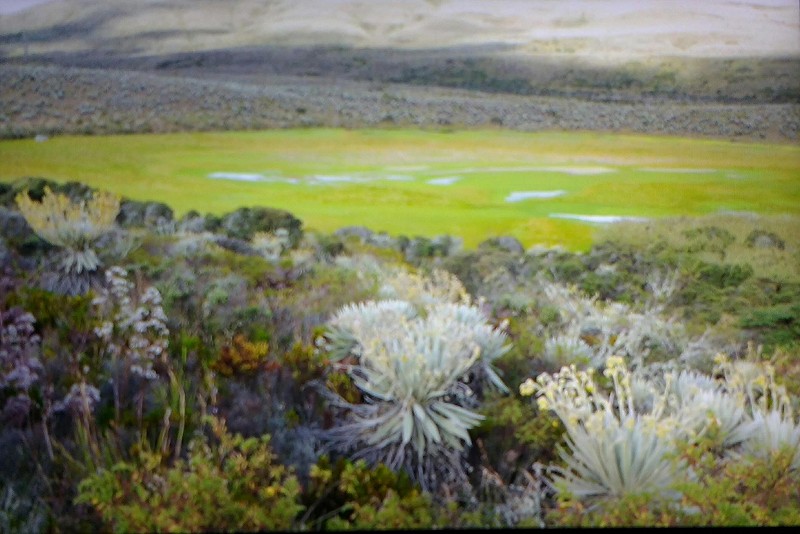Arjan Dwarshuis Biggest Year 16 september t/m 29 oktober
Zoals jullie weten sponsoren wij samen met Swarovski Optik, vogelaar Arjan Dwarshuis. Vanaf 1 janauri 2016 is Arjan in de race om in één jaar tijd zoveel mogelijk vogelsoorten over heel de wereld te zien. Hij wil het record op zijn naam krijgen, daarvoor moet hij meer dan 6.000 verschillende vogelsoorten zien.
Lees hier zijn vorderingen
September 16th MARVELLING AT THE MARVELOUS SPATULETAIL
We had one important mission before we would leave the Owlet Lodge and Abra Patricia, namely finding the endemic Yellow-scarfed Tanager. We had missed this bird around the Carpish Tunnel, so today was our last chance on finding this stunning Peruvian endemic.
Camilla and I were waiting at the feeders near the restaurant and Miguel and Juve were waiting downstairs with a walky-talky. After half an hour of waiting Miguel suddenly called in that Juve had found the Tanager in a mixed flock down at the gate. We raced down and after a tense 15 minutes we found the bird!
We drove down to the famous Rio Chido trail where Miguel and I were dropped off to search for the enigmatic Pale-billed Antpitta. Normally you take half a day to find this bird, but Miguel and I had to run up and down and see the bird within three hours’ time, if we would stick to our schedule. Juve dropped Camilla off at the feeders down in the valley so she could take some more time with the amazing Marvelous Spatuletail.
Miguel and I raced up and already after 20 minutes we found a small flock containing 2 Russet-mantled Soft-tails, a rare endemic that suffers tremendously from deforestation in this part of Peru. In fact the once very productive Rio Chido trail has been degraded over time to just a couple of small secondary forest patches, a sad sight indeed.
For the Antpitta we had to walk back for half an hour, since in our enthusiasm we had passed Miguel’s stakeout and walked half an hour too far uphill 🙂 Now began the tense wait for the Antpitta, one of my most wanted birds… After half an hour of waiting not a single call, but suddenly there was a movement and there – barely two meters from our perplexed faced – the antpitta popped up! What an amazingly cool bird!
We raced down, called in Juve and joined Camilla at the Spatuletail feeders and moments later we were reunited and marvelled at the most amazing hummingbird in the world! What a change from 10 year ago, when we had to work hard to find just a single bird along the road.
We continued down into the Utugamba Valley and picked up Speckle-breasted Piculet on the way. In the dry Marañón scrub lower down we tracked down the dazzling Marañón Crescentchest and we finished the day with yet another owl, the West Peruvian Screech-owl.
.JPG)
.JPG)
.JPG)
September 17th ENDEMICS OF THE MARANÓN VALLEY
The Marañón Valley is a huge dry inter-montane valley in north-western Peru and extreme south-western Ecuador. In this valley lives a unique bird community that is found nowhere else on earth. Due to human population growth and increasing infrastructure in this part of Peru many of Marañón’s special birds are now threatened. Today we would travel all the way down to the bottom of the valley near the small town of Balsas and up again to the city of Cajamarca. En route we would look for some of Peru’s most special birds.
Before we would drive down to Balsas we stopped to look for the endangered Chestnut-backed Thornbird, which was quickly found. Great to see that this species was still doing well on this side of the valley. At the bottom of the valley we saw the equally endangered Yellow-faced Parrotlet, but then we ran into trouble. The road was blocked because of road works and would only open after 1 PM. Our whole master plan was being jeopardized! There was only one option. I faked that I was feeling very sick and desperately needed to get to a hospital in Cajamarca for treatment. Miguel did all the talking and Camilla ‘took care of me’ with an utterly worried expression on her face. It worked, half an hour later we’d crossed the bridge, drove up on the other side and were back on schedule.
During several planned stops we picked up Buff-bridled- and higher up Grey-winged Inca-finch and finally Jelski’s Chat-tyrant.
Between Celendin and Cajamarca we stopped to look for the very rare and endangered White-tailed Shrike-tyrant. A poorly known species that has suffered enormously from cultivation of its grassy puna habitat. Against all odds we found this huge tyrant and since the identification can be quite tricky I made some quick record shots through my scope.
We had one big target still to find, the inexplicably rare endemic Grey-bellied Comet. This impressive hummingbird is only found along a few stretches of riverside vegetation near Cajamarca. Luckily Miguel knew a good stakeout for this incredible species and we found two males within five minutes after our arrival. That went differently 10 years ago when my friend Jelmer and I searched for this bird for two full days!
.JPG)
.JPG)
.PNG)
September 18th THE GREAT SPINETAIL AND THE PERUVIAN PLANTCUTTER
We had spent the night at the town of San Marcos in the middle Marañón Valley. This is the only accessible spot for the rare and endangered Great Spinetail. 10 Years ago I also visited this site and back than they’d just constructed a new road from Cajamarca to San Marcos. Back then I was already worried that this new road would have disastrous consequences for the then already rare spinetail because a good road means development and subsequently habitat degradation. It turned out that these worries were not without reason. The habitat that the spinetail favours had been almost completely destroyed and the land that still held good habitat had a ‘for sale’ sign on it.
Miguel knew where the birds had been nesting very recently – just a meter next to a recently burned acre of good habitat – so finding them was easy. We had to wait as it slowly got light until the birds started calling and not long thereafter we had good views of this rare species – which should be uplisted to critically endangered in my opinion.
From San Marcos we headed for the coastal town of Chiclayo, about half a day’s drive. En route we made a stop to look for the little known Unicolored Tapaculo and the recently split Piura Hemispingus, but we could only find the former.
When we finally arrived at Chiclayo we drove straight to Bosque Pomac reserve to look for the endangered Peruvian Plantcutter and Tumbes Swallow. We started with the swallow, but the light was so horrific that I didn’t dare to positively identify any distant swallow at this stakeout. With only half an hour of daylight left we raced to the area where the Plantcutter is most often seen and just as Miguel was telling that we might have to come back in the morning a bird started calling! Five minutes later we were marvelling at this amazing bird, a great finish to a long travel day.
September 19th WHITE-WINGED GUANS!
Last evening Wim ten Have had arrived from Lima, he would travel with us for the remaining three days in Peru and five days in remote southern Ecuador.
Today we were going to a special place – Bosque Frejolillo – one of the very few breeding sites of the critically endangered White-winged Guan. This beautiful bird was discovered in the 1870’s, but got ‘lost’ since until it was rediscovered in the ‘70’s, 100 years after its original discovery. The villagers of Limon de Porquilla – which lies adjacent to Bosque Frejolillo – now protect the Guans since they started to see the benefits from ecotourism. This has resulted in a dramatic increase of the population of the species from just one pair to at least eight pairs.
We arrived just after dawn at Limon de Porcuilla where we had our breakfast. We saw some cool Tumbesian endemics like Tumbes Tyrant and Tumbes Sparrow while having our morning tea. From here we walked up into the gorge and the deciduous forest where the Guans live.
After just 10 minutes of walking I suddenly spotted a guan perched in a tall tree! It turned out to be a flock of four birds, very cool. Later that they we would count at least 15 birds in total. Other good birds this morning were the vulnerable Grey-breasted Flycatcher, Quayaquil Woodpecker, Ecuadorian Trogon, Rufous Flycatcher, Red-masked Parakeet and Pacific Elaenia.
On the way back to Olmos we stopped to look for the endemic Cinereous Finch during the heat of midday, but luckily we quickly found three birds that gave fantastic views.
Our final addition to this great day was an unexpected flock of over a hundred Sulphur-throated Finches, an unpredictable nomadic species.
.JPG)
.JPG)
September 20th ABRA PORCULLA
We left Olmos early so that we would arrive at the famous pass of Abra Porculla at first light. This interesting place holds a unique set of birds that is only found here and in a remote part of south-western Ecuador. Unfortunately the habitat is much degraded at this location and the specialties are getting harder and harder to find every year.
We had a thrilling start when a Chestnut-crowned Antpitta showed tremendously well while we were having coffee. Always great to see a member of this difficult family this well. We were lucky today and within a short timespan we found all but one of our targets, Chapman’s Antshrike, Black-cowled Saltator, Rufous-necked- and Henna-hooded Foliage-gleaner, Gray-and-gold- and Three-banded Warbler and the porcullae race of Grey-throated Hermit. The Piura Chat-tyrant however proved more difficult and we spend the last 2 hours at this location chasing this rarity without success.
From Abra Porculla we drove back into the Marañón Valley to the town of Jaen. Here we visited a small local conservancy to look for two birds in particular, the Little Inca-finch – our last of 5 Inca-finches – and the critically endangered Marañón Spinetail. We found both these birds and especially with the latter I was very happy since this spinetail is getting more difficult to find every year according to Miguel.
September 21st CROSSING BORDERS
We started heading north from Jaen just after daylight since the road to Ecuador can sometimes be a dangerous one. En route we picked up two final birds for my Biggest Year bringing the total to 574 new birds in Peru. That is 124 species more then I’d expected, all respect to Miguel Lezama, Wim ten Have and Juvenal Ccahuana of Tanager Tours!
Together with these guys and Camilla we crossed into Ecuador, where the adventure continues…
Arjan Dwarshuis
http://www.arjandwarshuis.com/#biggestyear
http://world.observation.org/arjan.php
PLEASE MAKE A DONATION NOW
.JPG)
September 22nd ECUADOR!
Yesterday we had crossed the border into Ecuador and drove north towards Tapichalaca Reserve, which is part of the Jocotoco Foundation. We had spent the night in a small village downhill from the reserve and today we spent the whole morning birding the elfin forest along the road above Tapichalaca (Jocotoco) Lodge.
The Jocotoco Foundation has bought most of the land in this area so that the remaining forest is protected, a fantastic initiative. The flagship species of this reserve is the amazing and recently described Jocotoco Antpitta and it was this bird that became the emblem of the foundation. Tonight we would stay at the Jocotoco Lodge and tomorrow we will look for this iconic species along the adequately named Jocotoco trail.
By slowly roadside birding downhill from the treeline to about 2500 meters we saw some great birds like Golden-crowned Tanager, Mouse-coloured Thistletail, Neblina Metaltail and Little Sunangel, among others.
In the afternoon we drove down to do some birding around the lower cloud forest near the town of Valadolid. In this relatively unexplored area we found the elusive Spectacled Prickletail.
That night we stayed at the Jocotoco Lodge, what a wonderful place. Good food, nice rooms, hot water and Wi-Fi. Very welcome for a change 😉
.JPG)
September 23rd THE JOCOTOCO ANTPITTA
Today was THE day, the day that we would come face to face with the mythical Jocotoco Antpitta. This bird was described as recently as 1997 and back then this discovery generated much publicity in the international birding scene. It also became apparent that the bird was inexplicably rare and that its habitat was quickly vanishing. That’s when the Jocotoco Foundation stepped in. They bought a large track of elfin forest in the core range of the species and in doing so the future of the Antpitta is secured for now. Still it is urgently needed to protect the elfin forest that this bird calls its home.
Luckily the Antpitta can’t be missed at Tapichalaca since a pair is being fed on the Jocotoco trail. Nevertheless, we were feeling the tension as we slowly approached the territory across the trail. Suddenly Camilla made some weird squeak while hysterically pointing ahead on the trail and there – like a statue – stood the Antpitta. What a beast of a bird! To our amazement the bird – and its partner – started calling next to the trail in plain sight as if they were persuading us to hurry up with their breakfast, ridiculous! At the feeding site the local guide put out some worms and moments later we were marvelling at two Jocotoco Antpittas feeding away completely in the open! Wow, what an experience…
Yes, we also saw some other good birds this morning, like Chestnut-crowned Gnateater and White-browed Spinetail. After saying goodbye to Tapichalaca we drove in the direction of our next location, Buenaventure ‘Umbrellabird’ Lodge.
.JPG)
September 24rd UMBRELLABIRDS
After spending the night in the small town of Olmedo we arrived at Buenaventura reserve around 8 AM. It was cloudy and misty which meant that bird activity was still booming. While having breakfast near a small stream along the roadside we saw already a lot of new birds, best was a pair of Esmeraldas Antbirds – later the only sighting during our entire stay here.
After breakfast we started with some serious birding, looking for the many rare bird species that can be found in this area which forms a transition between wet Tumbes and pacific slope cloud forest. Some of our best finds this morning included the vulnerable Pacific Royal Flycatcher, a pair of the endangered Grey-backed Hawk and a pair of endangered Slaty Becards.
In the afternoon we checked in at Buenaventura Lodge, a fantastic place in the heart of the reserve, which is managed – like Tapichalaca – by the Jocotoco Foundation. It was hard to bring ourselves to first have a look at the rooms since there were literally hundreds of hummingbirds at the lodge’s feeders.
In the afternoon we set off on the Umbrellabird Trail to visit the lek of one of the most impressive birds in the neotropics, the Long-wattled Umbrellabird. This huge black bird with umbrella-like crest and bizarre long feathered wattle, has become increasingly rare over the course of the last decades due to habitat destruction and hunting. Luckily it is still very reliable at Buenaventura.
After about 15 minutes of walking downhill we arrived at ‘the’ spot, but we weren’t sure whether we were at the right spot. Suddenly Camilla made that same squeaky sound that I remembered well from yesterday morning when she saw the Antpitta, but this time she could only stutter and franticly point at a huge black bird that sat silently right above our heads; a male Umbrellabird!!
For the next hour we watched one of the most amazing displays in the avian world. The bird sits motionless like a statue for what seems an eternity, but at a certain point it leans forward, fans out its crest and its wattle while it puts its head in its neck and then delivers a deep foghorn like ‘OOOOOOEEEEEEEE’. Simply amazing.
Beer tasted good that night at the Umbrella lodge, especially since we were kept company by a very showy Black-and-white Owl feeding on moths that were attracted to the lodge’s lights, and a cheeky Kinkajou stealing bananas that were put out for the tanagers.
.JPG)
September 25th FRUSTRATING EL OROS
This morning we went to the higher part of Buenaventura to look for two endangered and highly localized specialties, the El Oro Tapaculo and El Oro Parakeet. For both these threatened species Buenaventura holds the largest know population.
As we drove up it became clear that we had a difficult assignment since it was a bright sunny day, not the best conditions for finding either species. From November onwards the Parakeet is easy since it breeds in specially constructed nest boxes, which are well known with the local guides. This time of the year however, they are unpredictable and thin on the ground.
We started with the Tapaculo, which was luckily singing upon arrival. Seeing the bird however proved incredibly difficult and despite getting very close, it remained hidden in the thick understory.
We spent four long hours waiting for the parakeets to land in one of the surrounding treetops, but we didn’t get lucky. Finally we heard a group of El Oro Parakeets calling while they flew overhead, but it was impossible to get a view against the bright blue sky. The second time this happened I could just see five parakeets disappear over a distant ridge… I will have to come back for better looks at this rare bird.
While driving back to the lodge for lunch Juve picked up a very welcome family of Rufous-headed Chacalacas along the road. Later this turned out to be our only sighting of this threatened species.
We spent the afternoon on the trails with few additions like Spotted Nightingale-thrush and Russet Antshrike.
.JPG)
q.JPG)
.JPG)
September 26th SAYING GOODBYE TO TANAGER TOURS
Today was our last day with Tanager Tours, the single birding organization with whom I’ve seen – and probably will see – the most new birds this year. This mammoth one month tour through almost every corner of Peru and south-western Ecuador was unbelievably successful and surpassed all of my expectations. Besides the fact that Miguel managed to show me almost every endemic and specialty that we tried for, he and Juve ran this tour smooth as a whistle – and that’s very impressive in the often unorganized country of Peru. Camilla and I felt save and in the best hands possible at all time during this trip and for any birder planning to visit the most diverse birding area in the world, I can only highly recommend to do this with Tanager Tours.
My personal top 10 this trip:
- Long-wattled Umbrellabird
- Wattled Curassow
- Golden-backed Mountain-tanager
- Jocotoco Antpitta
- Long-whiskered Owlet
- Pale-billed Antpitta
- Long-tailed Potoo
- White-bellied Cinclodes
- Royal Cinclodes
- White-winged Guan
- Andean Cock-of-the-rock (displaying of course)!
And today we finished with eight more additions to the list, three of these were very cool ones: White-tipped Sicklebill, Brownish Twistwing (actually twisting its wings!) and the endangered Grey-cheeked Parakeet!
Tanager Tours, Miguel, Juve and Wim, we will miss you!
September 27th TO SANI LODGE
Last night Camilla and I had arrived in Quito, where we spent our final evening together this year. She will continue to the US to stay with her brother for a month and I will continue hardcore birding till the 1st of January 2017!
After enjoying a relaxing morning at our B&B in suburban Quito it was time to say goodbye and head for the Quito Airport. From here I flew one hour to the Amazonian town of Coca from where the boat leaves to Sani Lodge. At the airport I was picked up by the very helpful Sani staff and my guide for the next four days, Olger Licuy, one of the best guides in Ecuador and definitely the best in this part of the Amazon. Together we will try to track down as many of my remaining Amazonian possibilities as possible.
The boat ride across the Napo River to the Sani community dock takes about two hours and on the way you come across all human activities that threaten this incredibly complex and fragile ecosystem. Mining, drilling for oil, transportation of hardwood etc. etc. When we finally arrived at the Sani community the ‘normal’ tourists went to the lodge and Olger and I started birding the productive mix of secondary forest, varzea and swamps that surround the village. In fact the first target we saw – Black-banded Crake – was right in someone’s backyard. Other highlights that afternoon were Chestut-capped Puffbird and my first glimpses of White-lored Antpitta.
From the community we walked for a kilometre across a wooden boardwalk through beautiful varzea to a small dock. From here we went by wooden peddel canoe to the lodge – motorized boats are forbidden within the community conservancy. The approach to the lodge across a beautiful oxbow lake makes you wonder wether you’ve arrived in heaven, simply perfect tranquillity rarely encountered anywhere in the world. I’ve arrived at Sani, the finest birding lodge in the Amazon!
A little context to Sani Lodge:
Sani is a community of about 70 families living on the north bank of the Napo River opposite Yasuni National Park. As a community they started the Sani Lodge, a beautiful ecolodge run by and for the community. All money earned from tourism goes to the community and all the staff members and guides are from the Sani community. The forest around the lodge – which is beautifully situated at the edge of a black water oxbow lake – is exceptionally pristine and some of the rarest Amazonian birds are found with relative ease in the vicinity of the lodge. In addition to all this the Sani are known to have about the sharpest eyes of all native Amazonian communities and subsequently the guides are top notch. I spent my four days in company of the best of the best, Olger Licuy.
September 28th RARE ANTBIRDS ALONG THE NAPO
We set out at 3:00 (!) AM this morning since Olger wanted to be in Yasuni NP on the other side of the Napo River before daybreak, so that we could try for Nocturnal Curassow. It was a fantastic experience to be on a wooden peddle canoe with just the sounds of the rainforest around us.
We arrived at the other side of the river at 4:00 AM, quickly had our packed breakfast and coffee and headed into the jungle on a small winding trail. We heard three different Crested Owls, a Black-banded Owl and two Long-tailed Potoos, but the hoped for Curassow did not call unfortunately. As it slowly got light diurnal birds started to give their dawn chorus and among these were Collared Puffbird and White-rumped Sirystes, but best was a Rusty-belted Tapaculo that gave exceptional views as it sang from a log on the forest floor.
From then on it got a little bit quiet until a short shower, after which birdlife exploded again with rarities such as Brown Nunlet and Sooty Antbird. As we continued along the trail we were suddenly amidst a huge army ant swarm and judging by the calls coming from the understory there were army ant followers with them. The next half an hour was very special. I saw five mega cool antbirds hopping around between the ants trying to catch insects that were fleeting from the thousands of ants. We saw White-cheeked Antbird, Lunulated Antbird, White-plumed Antbird, a smashing Reddish-winged Bare-eye and a Hairy-crested Antbird as the icing on the cake.
The way back to the boat was equally exciting with some nice understory flocks that contained Yasuni- and Ornate Antwren. Probably the bird of the day was an extremely obligating Banded Antbird that crept across the forest floor giving its piercing high song, incredible!
We had lunch at the Sani Community where in addition to delicious freshly caught fish wrapped in banana leaves I ate grubs for the first time in my life. Huge beetle larvae that were slow-cooked on a wood fire. They were delicious, strangely reminiscent of the Dutch snack ‘kibbeling’ (fried fish).
In the afternoon we birded the swamps and varzea forest around the community which proved exceptionally good with 3 major highlights, Black Bushbird, Black-bellied Thorntail and a male Fulvous Antshrike! What an incredible first day at Sani Lodge!
.JPG)
.JPG)
September 29th BIG BIRDS
Another early start today, this time we left Sani Lodge at 4:00 AM to look for the rare Rufous Potoo. Again conditions seemed perfect, but like the Curassow this bird wouldn’t call.
Immediately after first light we headed for the canopy tower. En route we saw the amazing Agami Heron from the canoe, one of those classic Sani specialties. The Sani canopy tower is one of the best in the world and is situated 40 meters high in the crown of the largest rainforest tree I’ve ever seen. The view over the forest canopy is absolutely breath-taking and especially the sunrise was an experience I will not soon forget. We saw some good birds in the hour we spent up here. Best were Ivory-billed Aracari, White-necked Puffbird and already my 3rd Harpy Eagle this year. Like every time you see a Harpy your breath stops for a couple of seconds when this huge raptor flies by.
Until lunchtime we birded the trail system behind the lodge where we found the most renowned Sani specialty, the range restricted Cocha Antshrike. Other highlights on the trail were Collared Puffbird, a very showy Great Tinamou, a Long-tailed Potoo and both Purplish- and White-chinned Jacamar.
After lunch we set out to the Napo River again to look for Amazonian Umbrellabird and after just 15 minutes of boating a female Umbrellabird flew across the river and landed in a secropia tree on a small river island. Fantastic, my second Umbrellabird species in just a week’s time!
.JPG)
.JPG)
.JPG)
.PNG)
.PNG)
September 30th WING-BANDED ANTBIRD!!!
Olger asked me last night over diner at Sani Lodge, which bird do you really want to see most? I answered the ultra-rare Wing-banded Antbird. ‘But I haven’t seen that bird in 5 years’! Olger replied. ‘Well I just lay it out for you to play it out my friend!
And so it began… At 3:00 (!) AM (again) I found myself on a wooden peddle canoe with Olger and a young trail guide armed with a machete for the dirty work. In the background a Nocturnal Curassow was booming while we set out into the night. It was still in the twilights when we arrived on the other side of the Napo River at the edge of Yasuni NP. I followed Olger and the young trail guide as he hacked his way through thick riparian vegetation. Meanwhile we were getting hammered by an angry swarm of horseflies the size of bumblebees. Then we arrived at the ’trail’. For an hour we made our way knee-deep through a swamp with fallen logs. I knew that after so much hardship a great prize was surely waiting for me on the other side of this swamp…
When we made it to the terra firma we could finally cover some ground and half an hour later Olger froze. ‘I hear an Ochre-striped Antpitta’! One of the most elusive of all antpitta’s that is. For an hour we chased the beast through thick undergrowth, but I couldn’t get a view. Finally Olger decided to try to ‘push’ the bird in my direction from the other side. Olger was circling the bird and I was waiting silently on both knees in the mud while being covered in a humming cloud of thousands of bloodsucking mosquitos. Suddenly there was a movement in the undergrowth! I aimed my binoculars suspecting to see the Antpitta, but there in plain view set a WING-BANDED ANTBIRD!!! For 10 full seconds the mosquitos seemed to have vanished while I watched this stunning bird with open mouth. Then another movement 5 meters to the right as the Antpitta hopped into view! A glorious Biggest Year moment indeed.
On the way back we saw two other very nice birds, the Orange-crested Manakin and a showy Chestnut-headed Crake.
Later in the day we walked a long heavy undulating trail to a lek of Black-necked Red-cotinga, but despite my high hopes none were calling. I did see four new birds, best were Olivaceous Flatbill and a Biocoloured Conebill on a river island.
October 1st LEAVING SANI
With pain in my heart I had to say goodbye today to beautiful Sani Lodge. What an amazing place this is. Luckily we had two more hours on the trail and amazingly Olger managed drag out 3 more new birds for me, namely Cinnamon-rumped Foliage-gleaner, Scaly-breasted Woodpecker and the rare Orange-eyed Flycatcher. And I almost forgot, we also got a flock of 6 Grey-winged Trumpeters.
Here’s my list from Sani, I can hardly believe I saw this in a fourth night J All thanks to Olger Licuy, one of the finest guides I’ve ever worked with. This is THE guy you need for the Ecuadorian Amazon, but apparently he is fantastic in the whole of Ecuador so please don’t hesitate to book him!
- Wing-banded Antbird
- Harpy Eagle
- Banded Antbird
- Black Bushbird
- Cocha Antshrike
- Reddish-winged Bare-eye
- White-chinned Woodcreeper
- Lunulated Antbird
- Rusty-belted Tapaculo
- Agami Heron
- Collared Puffbird
- Yasuni Antwren
- Grey-winged Trumpeter
- Orange-crested Manakin
- Ochre-striped Antpitta
- White-lored Antpitta
- Chestnut-headed Crake
- Black-banded Crake
- Purplish Jacamar
- White-cheeked Antbird
- Brown Nunlet
- Fulvous Antshrike
- White-necked Puffbird
- Long-tailed Potoo
- Nocturnal Curassow (heard only)
- Amazonian Umbrellabird
- Black-bellied Thorntail
- Ecuadorian Cacique
- Bicoloured Conebill
- Orange-eyed Flatbill
- Hairy-crested Antbird
- The second documented record of Little Ground-tyrant for EcuadorPfeeeeeeeeeew….. Time for a beer
October 1st A DUTCH REUNION IN QUITO
After my fight from Coca to Quito I took a taxi to the house of my friend Dusan Brinkhuizen. Dusan – a fellow Dutchman – lives in Ecuador with his wife for many years now and guides for Rockjumper Tours. Up until two months ago Dusan would have guided me in Ecuador, but then the unthinkable happened; he horrifically broke his leg while playing basketball. Luckily Dusan will recover completely, but it will take another 3 weeks before he can walk without crutches. So for the next 8 days I will be birding on my own in Ecuador with Dusan’s trusty driver Rolando. Dusan will guide me from a distance and I will leave with all his sound recordings and detailed site information. This will be one of the biggest challenges of my Big Year especially since I’ll be covering the Choco Lowlands, one of the tougher regions in the Neotropics…
Dusan and his wife gave me a warm welcome when I arrived at their lovely apartment in suburban Quito and while I enjoyed a lunch I could add – according to Dusan – the only Crimson-backed Woodpecker in Quito to my list. After lunch the 3 of us took a taxi to Dusan’s local patch, the Quito Botanical Gardens. For him this was the first time to go birding in two months, for me it was the first time to be birding with a cripple this year 😉 Handicapped as he might be, Dusan was still sharp as ever and he managed to find me my first Yellow-green Vireo for the year.
That evening we drank beer and planned my loop through northwester Ecuador in detail.
October 2nd MIST MAKES LIFE DIFFICULT
Early morning I was picked up by Dusan’s trusty driver Rolando and together we headed towards Yanacocha Reserve, an hour’s drive from Quito. This reserve is famous for having the critically endangered Black-breasted Puffleg, but this bird has not been seen for a long time. Still there are some other great birds to be found in the elfin forest.
My first target was the beautiful Black-chested Mountain Tanager which I luckily found quickly. The other 3 important once were all hummingbirds which are to be looked for around the feeders at the end of the track. By mimicking the sound of a pygmy owl however I had lured in all three species – Sapphire-vented- and Golden-breasted Puffleg and Buff-winged Starfrontlet – before getting there, so I turned around and we headed for Bellavista Reserve. I had very high expectations of this place since 3 awesome birds are quite regularly found there, namely Occelated Tapaculo, Plate-billed Mountain-toucan and the rare Tanager Finch among a long list of other good birds.
Because I had such high expectations arriving in thick mist was a real mood killer. I couldn’t even see the tree tops let alone identify birds in it. The weather conditions gradually got worse and worse and after frustratingly hearing, but not seeing both the Toucan and the Tapaculo I was starting to not so like Bellavista. When it was 5 PM I couldn’t see further than 5-10 meters ahead and because so it was too dark to do any birding by 5:30 PM. I left Bellavista defeated, hopefully tomorrow I will be back in the game.
October 3rd BACK IN THE GAME!
I had a full day at Maspi Reserve today birding the high and middle part in the morning and the lower part in the afternoon. Potentially there were a lot of new birds to be found here especially since I would cover about a kilometre of altitude difference. Unlike yesterday the weather was good, overcast and a little misty, but not too much; perfecto!
The day started well with a couple of nice flocks with highlights like Pacific Tuftedcheeck and my first of many Orange-breasted Fruiteater, one of the better looking Cotinga’s out there! One of the highlights of the morning was a stunning Moss-backed Tanager, which look more like a Cotinga than an actual Tanager.
From 8:30 till 10:30 I birded the area around Reserva Amagusa . The feeders at this place guarantee the amazing Empress Brilliant, a huge hummingbird with a deeply forked tail and as expected I saw several. Birding the entrance road to the reserve brought a huge surprise. I saw some alarming passerines around a thick vine tangle and to my amazement there was a Colombian Screech-owl perched up there! This is a rare owl and as far as I know there are no daytime roosts known in Ecuador!
I spent the rest of the day in the middle and lower part of Mashpi chasing targets that Dusan said I had to find here. Highlights were Barred Puffbird, 3 Barred Hawks and best two stunning Orange-fronted Barbets, a bird I absolutely needed to get here. An awesome day with 31 new birds for my year. As it is going now I’m fast moving towards a new world record!

October 4th DIPPING GIANT ANTPITTA 🙁
I had an easy morning ahead of me, at least that’s what I thought… From 6 AM to 10 AM I had the classic tour at Paz de las Avez with the legend himself, Angel Paz. Angel started to feed a wild Giant Antpitta about a decade ago and thereby initiated an innovative new way to see shy skulking birds. ‘Mealworming’ is now practiced all over the world and especially in Asia – where photography is hotter than hot – it is very popular. For the last months 4 different Antpitta species had been coming daily to Angel Paz’s tasty mealworms so I was geared up for the show. Mother Nature however had a different plan in mind and I would find out once again that even ‘tame’ Antpitta’s are still wild birds – and maybe that’s a good thing in the end.
The morning started fantastically well with lekking Cock-of-the-Rocks and 3 Dark-backed Wood-quails running – literally – between Angel’s legs to get as fast as possible to his tasty banana – some fruits – that he had put out there for them. Then it was time for the moment of truth, the Giant Antpitta! We went to the feeding site, Angel called the bird ‘Maria!’ ‘Mariiiiiiiiiiaaaaaa’! I was ready with my camera, but the bird did not came and an hour later still nothing… I was getting worried. We quickly ‘did’ the Yellow-breasted Antpitta and 2 obligating Rufous-breasted Antthrushes and then went back to the Antpitta, but still nothing. Around 9 AM we had to give up on this legendary species and I was almost crying. To make things worse the virtually guaranteed Moustached Antpitta also did not show itself. Luckily there was Shakira. A hot little Ochre-breasted Antpitta with a lovely big eyes and a sexy little butt. She eased the pain of dipping the giant a bit.
After this debacle we drove towards the coastal town of Penas. We arrived at 4:30 PM which gave me just enough time to find my most important targets, a fantastic Pinneated Bittern, Stilt Sandpiper, Short-billed Dowitcher, Panamanian Flycatcher, Snowy-throated Kingbird and Jet Antbird.
October 5th BIRDING THE CHOCO LOWLANDS, OR WHAT’S LEFT OF IT…
Dusan had send me on a difficult and quite dangerous mission, namely to bird the Choco lowlands of Yarale National Park. Few birders venture here for several different reasons. It is full of bandits and thugs, the habitat is heavily degraded, you bird along a highway and there are very few tourist facilities. The rewards of a day birding in this seemingly unfriendly place can be grand!
I started the morning birding along the main road that runs through the now heavily degraded Yarale ‘Reserve’. Rolando was never further than 100 meters away with the car so that we could drive of if anything smelled fishy. I started off with a bang, within the first 5 minutes after arrival I saw a Black-breasted Puffbird and a pair of the vulnerable Scarlet-breasted Dacnis, 2 of my main targets. In the hour that followed I found a female Black-tipped Cotinga, more Dacnisses, Spotted Antbird, Slate-throated Gnatcatcher and the for Ecuador very rare Speckled Mourner.
In the late morning and afternoon I birded the much quieter dirt road that runs uphill from the tiny town of San Fransisco. This track runs through secondary forest, but don’t let it fool you, some Choco blockers can be found here. The main attraction is the dazzling Five-coloured Barbet, which strangely enough has only 4 colours, two of which are black and white which are technically not colours J It took some time, but eventually it was Rolando who located a singing bird in the canopy, awesome! Other highlights were Scarlet-tighted Dacnis, Red-lored Amazone, Rufous Piha and best of course a male Blue Cotinga.
Dusan’s plan thus far worked out nicely with 26 new birds today of which many I will not see again this year!

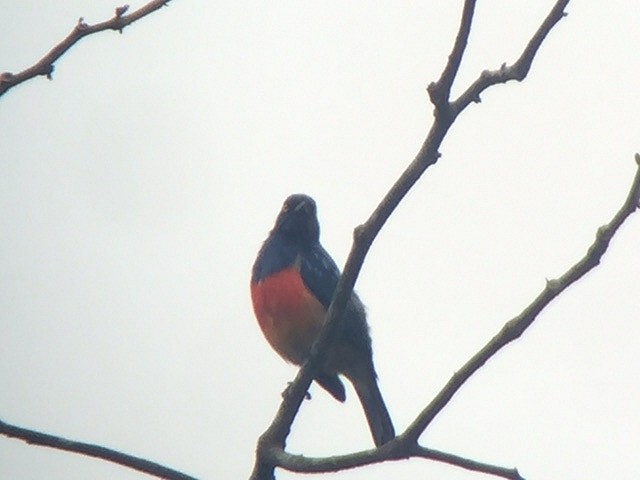
October 6th THE AWA TRACK
Part two of Dusan’s grand master plan was to send me up the Awa Track. He must have had high expectations of me since this track is about as tough as it gets. First of all you can hardly call it a track, it is an extremely muddy, wet and slippery path that runs through partly degraded habitat in the lower Choco foothills. It is almost always misty and horribly wet and if you’re looking for a nice opportunity to break an ankle, this is the place to be! But if you survive the track and make it back in one peace, you might have seen some birds that very few people have ever seen before you…
Of course I was hopeful that like so many other times this year I would have fantastic weather this morning at the Awa Track. When I arrived this hope quickly vaporized; it was so misty you could barely see your binoculars in front of your eyes and the track was even muddier than I had imagined it to be – I guess the photo says it all. Luckily Dusan had told me over and over again to STUDY THE CALLS. And so I did, for two full hours last night! This paid off, I quickly picked up and taped in my first Awa mega, a beautiful male Stub-tailed Antbird, followed quickly by a Choco Tapaculo. As I battled on across the horrific looking track I picked up quite a lot of lifers, but none of the hoped for mega’s other than the antbird.
Around 10 AM I had to turn around because at 1 PM we had to leave for Quito. There, on the way back I got my moment of awesomeness, the mist disappeared for half an hour and in that time I found 4 MEGA BIRDS: Choco Woodpecker, Lita Woodpecker, Yellow-green Bush-tanager and the stunning Golden-chested Tanager. Mission Accomplished!
To top things off we made a stop at Dusan’s secret stakeout for the rare Ecuadorian Rail and this fantastic bird put on a show I will not soon forget!
When I arrived back at Dusan’s place that evening I met a happy ‘coach’, despite the fact that he just came back from the hospital for a leg operation.
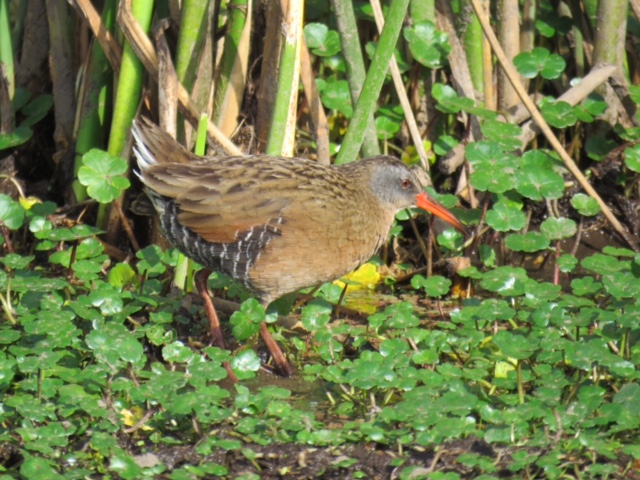
October 7th EAST SLOPE LEVEL 1 TO 5
Dusan had send me on an even tougher assignment than yesterday, I would have to do the entire East Slope in a single day. In the footsteps of his record breaking Big Day last year wherein he and 3 other birders saw a whopping …. species in a single day.
The first ‘level’ I had to complete was the highest pass in Ecuador around the famous antennas. We arrived late due to road works, but luckily the weather was exquisite. I found most of the targets while driving up, most importantly the dazzling Ecuadorian Hillstar. The most important bird was the Rufous-bellied Seedsnipe and after a tense half an hour of searching around the antennas I found a pair of my last species of Seedsnipe in the world. After getting a Carunculated Caracara right when my time was running out we had to move to the next site.
For level 2 I had to find a couple of normally fairly easy species in the Elfin forest, but it was too sunny and windy which made birding extremely difficult. Again in the nick of time I found my main target Agile Tit-tyrant.
At Guango Lodge Dusan had given me exactly half an hour to find Tourmaline Sunangel at the feeders and a lot more difficult, Mountain Avocetbill at his secret stakeout. Of course the Sunangel was a piece of cake, but the Avocetbill took 20 minutes before it finally appeared, but what a great bird!
Next up was the San Isidro area in at the transition zone of Elfin to cloud forest. Despite the fact that it was midday and death quiet I managed to find some incredible species, again thanks to Dusan’s detailed site info. Most awesome were White-bellied Antpitta and Barred Antthrush, both of which I saw incredibly well.
After 2 more stops we finally arrived around diner time at the in infamous Wildsumaco Lodge, my home for the next 1,5 days. Wildsumaco offers probably the finest birding in the entire Andean foothills and since I would have help from their incredible local guide Byron I was bound to find some amazing birds.
October 8th WILDSUMACO
I was overlooking the feeders around the veranda of Wildsumco just at is was getting light. In the 15 minutes before breakfast I saw two amazing new hummers, Wire-crested Thorntail and Black-throated Brilliant. After a wonderful breakfast it was time to set off on the Face Trail with Byron. As I said earlier Byron is sensational and he picked up on every little call, including all the migratory species. On rare occasions I feel completely useless in the presence of a local guide, and today was one of them, Byron literally found everything. The only bird I could point out before him was a Coppery-chested Jacamar, but he found 3 of those over the course of the morningJ.
Around lunchtime ‘we’ had found over 20 new species for my Biggest Year, including some mouth-watering rarities: White-streaked Antvireo, Plain-winged Antwren, Military Macaw, Yellow-throated Spadebill, Grey-throated Leaftosser and even Grey-tailed Piha.
After a delicious lunch with Napo Sabrewing in the background – in addition to incredible birds Wildsumaco serves incredible food – we set out again. A big afternoon shower that lasted over an hour cut our birding time short, but despite that we saw the diminutive Golden-winged Tody-flycatcher, a much wanted bird for me.
We finished the day in style with two fantastic new owls, Band-bellied Owl and the localized Napo Screech-owl. And after all that birding – 28 new birds! – we enjoyed another delicious meal and a cold beer!
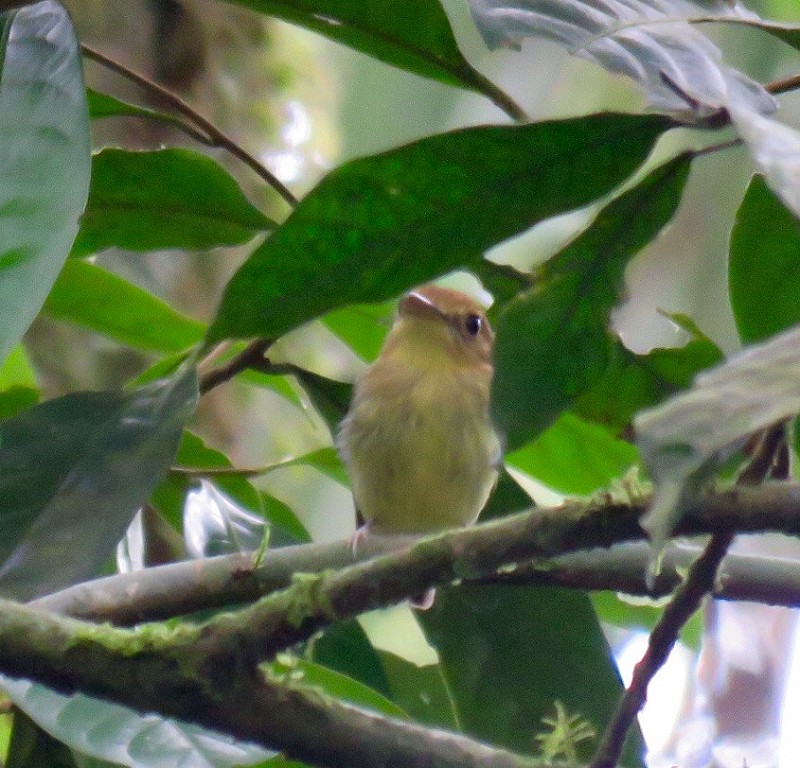
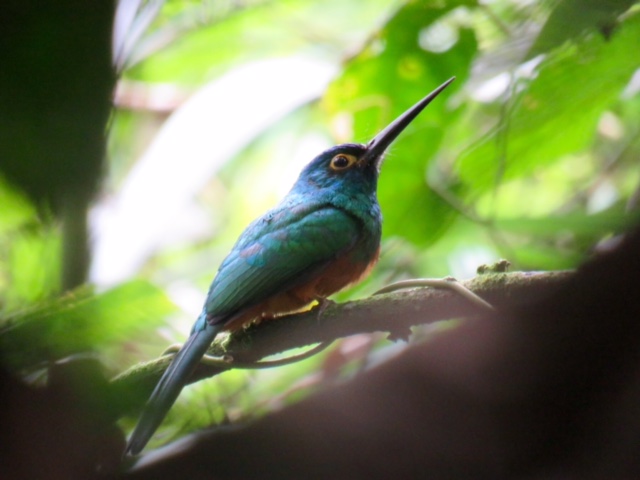
October 9th ON TO COLOMBIA!
Already my last morning in Ecuador and as can be expected on the East Slope it was raining. Still we started with a real blacker, Gorgeted Woodstar at a flowering bush in the lodge garden.
As Byron and I set out to look for Plain-backed Antpitta we stumbled upon a very rare bird, an adult Buckley’s Forest Falcon, amazing. But after that it started pouring down heavily so I decided that it was time to start working my way up again towards Quito. I saw some amazing birds at incredible Wildsumaco and I will come back here as soon as I can!
Rolando and I made a couple of scheduled stops at the same spots of the day before yesterday. This yielded a few more new birds for my year. The best bird however I spotted from the car, a huge juvenile Black-and-chestnut Eagle circling over a ridge! What an amazing bird to finish my 19 days in Ecuador with.
I want to thank Dusan Brinkhuizen and Rockjumper Tours for making this ridiculous trip (309 new birds for my year) possible!
On to Colombia!
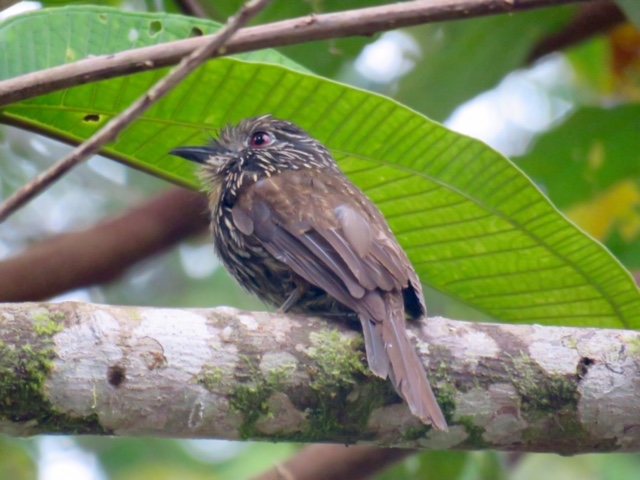
Preface
In the late evening of Oct 9 Arjan arrived at the Bogotá hotel where we (Dutch birders Gerjon Gelling, Garry Bakker and Remco Hofland) were waiting for him after three days of getting used to the time zone and altitude. There he was: slim, rough-bearded, lightly packed, with roughly 337 birds to go to break the world birding record. We exchanged news and listened to his stories about northern Ecuador, and were surprised by his enthusiasm, even after nine months, to go out birding the next morning.
October 10th: BOGOTA RAIL
The early morning of Oct 10 saw us at the Siecha marshes, where Alejandro Pinto of Colombiabirding guided us to the part of the marsh where GG, GB and I had seen Bogota Rail two days earlier. Noble Snipe, Solitary Sandpiper and Yellow-hooded Blackbird (all new) and Spot-flanked Gallinule (new taxon, with greener bill than the one seen in Argentina) were seen well, before bagging the rail with great footage to boot.
We continued towards Chingaza NP where we bumped into a bird we didn’t expect to see: Coppery-bellied Puffleg (usually easy at Observatorio de Colibris, but not in the past couple of weeks). Other interesting birds included Rufous-browed Conebill, Silvery-throated Spinetail and Black-backed Grosbeak, while Red-crested Cotingas were seemingly everywhere.
The Observatorio de Colibris duly produced Blue-throated Starfrontlet (along with more Red-crested Cotingas and some spectacular Sword-billed Hummingbirds). A rainy afternoon followed, with roadside birding near Mundo Nuevo producing Ochre-breasted Brushfinch, Northern Mountain Cacique and Buff-breasted Mountain-Tanager. The feeders in Mundo Nuevo proved a great place to spend the remaining rainy hours of daylight, with Lazuline Sabrewing, Short-tailed Emerald, Green-bellied Hummingbird and Longemare’s (Amethyst-throated) Sunangel as highlights. While the three of us walked the village looking for Black-and-white Owl, a bird Arjan saw several of during his Biggest Year, Arjan concentrated on writing an article (and we dipped). The pre-dinner foray long the access road was more succesful, with a beautiful male Lyre-tailed Nightjar. We had a quiet night at this charming little village, set between two green hillsides with a couple of Dutch-looking cows and stands of native forest, and the ever-present sound of the river coming from below.
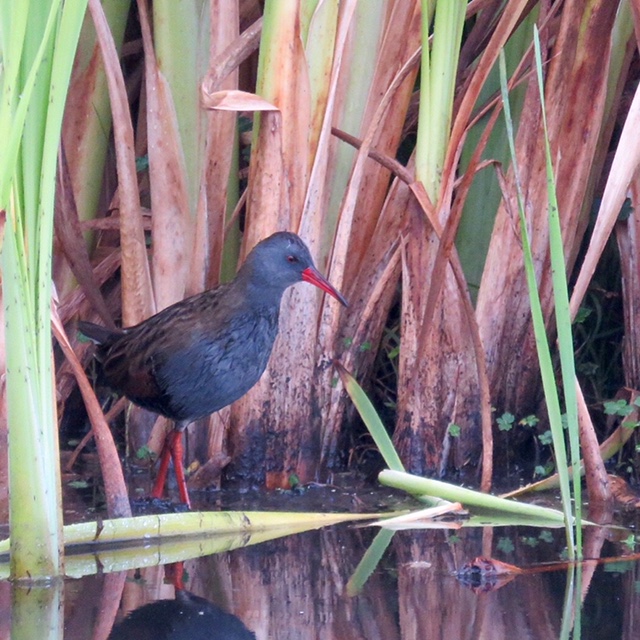
October 11th: CHINGAZA NP
Fortunately, we were lucky with the weather when at 5 am we drove up into Chingaza NP in the oldest Toyota Landcruiser of Colombia over the roughest back road of Colombia (although, in fact, the country has more of both). Almost as soon as we got out of the car, on the edge of fincas and cloudforest, we saw the vulnerable Flame-winged (Brown-breasted) Parakeet, followed by great views of a pair of Black-billed Mountain-Toucan, a bird Arjan had only heard in Ecuador. We then basically walked the first 100m of the trail until we encountered good stands of Chusqea bamboo where, with perseverance, we eventually had good views of the endemic Matorral (Pale-bellied) and the odd (large & long-tailed) Ash-colored Tapaculo. At one point, an unexpected Rufous Antpitta hopped into view as well, much to our delight. Back at our b&b in Mundo Nuevo at 8 am, we were treated to a second breakfast (after the one we enjoyed at 4.40 am), as well as scopeviews of a pair of Torrent Ducks in the river below.
Thick Bogota-edge traffic aside, our 4-hr drive to Sumapaz NP was uneventful. However, our afternoon at this beautiful high-paramo park, the biggest of its kind in the world, wasn’t. Our prime targets for the Biggest Year were Apolinar’s Wren, easily found, and two hummingbirds: Green-bearded Helmetcrest and Bronze-tailed Thornbill. The former is a great-looking creature with a long crest and beard (relatively long that is, for a bird the size of a ping-pong-ball) – at least, I think it’s great-looking because despite walking around at 3,700m altitude for five hours, I never saw one perched. And this is said to be the easiest of the two hummers! In fact, for the first couple of hours the highlights, aside from the wren, consisted of several Tawny Antpittas, cute Andean Tit-Spinetails, a Black-breasted Buzzard-Eagle and a Jameson’s (Andean) Snipe feeding at close range. After having walked 3 km’s up and down the road, all we had to show for hummer-wise were three distant fly-by’s and a female hovering in front of a yellow flower for 3 secs (its head obscured by a flower in my case) before it disappeared over a vast expanse of ‘pygmy palmtrees’ (I’m no botanist, suggestions to the ID welcome).
Things improved when at 3 pm we encountered several Tawny-rumped Tyrannulets, a cute nomadic flycatcher that usually is hard to connect with. Even better were the waders found on the edge of the beautiful lakes and ponds in this extraordinary landscape. We enjoyed good views of a first-winter Wilson’s Phalarope and several Greater Yellowlegs before a Calidris sandpiper flew past, which we immediately recognised as White-rumped Sandpiper. We shouted it out to Alejandro & Arjan, who stood 500m away from us, knowing it was one of the few Nearctic waders still lacking in the Biggest Year. Arjan explained he had also recognised the bird, informing Alejandro who, much to his dismay, missed it – as this was not only a rare Colombian migrant but also a lifer! While trying to relocate the sandpiper, Arjan and I saw a small hummer fly our way and moments later we were all enjoying frame-filling scopeviews of a male Bronze-tailed Thornbill perched on top of a roadside bush. Then, in the last half hour of daylight, Arjan found a small flock of Calidris, that turned out to consist of two Baird’s and no less than three White-rumped Sandpipers. We took record shots and video of the distant flock; Alejandro vowed to be back later in the week to try and obtain better views and footage of his unexpected lifer. That night in our Bogota hotel, José Castaño of Colombiabirding joined the party: he’ll be with us until the end of the Biggest Year’ Colombia leg.
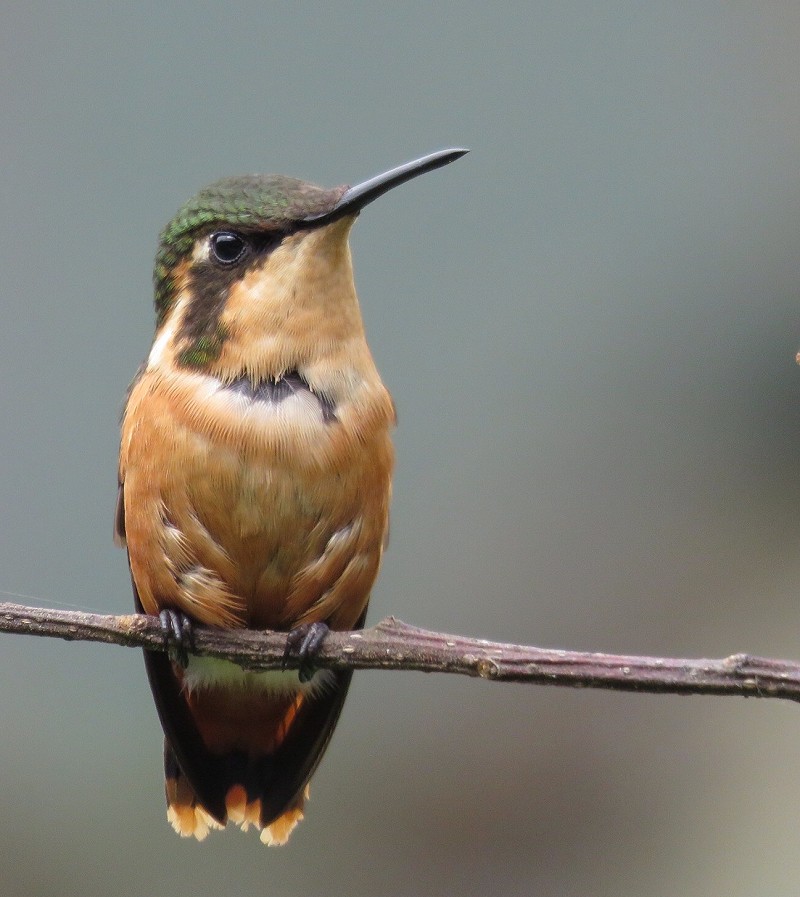
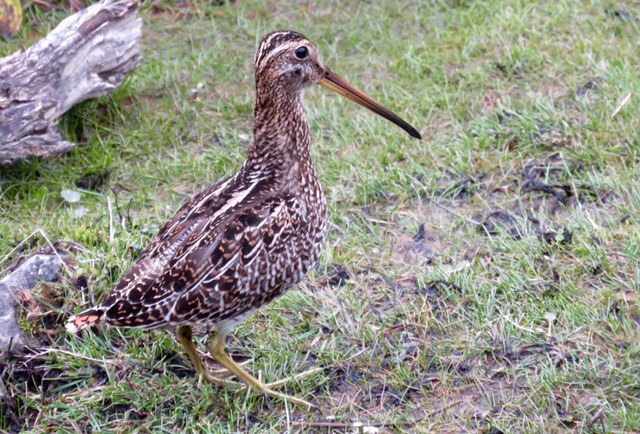
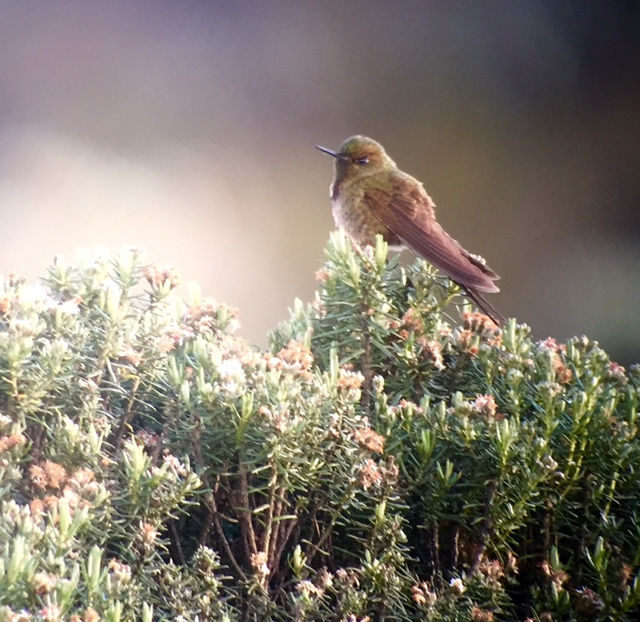
October 12th: PEDRO PALO: TURQUOISE DACNIS
In the morning of Oct 12 we were to bird Pedro Palo. Targets for The Biggest Year, Colombiabirding owner Diego Calderon had established pre-trip, were the endemic Turquoise Dacnis, along with Moustached Brushfinch & Rosy Thrush-Tanager. Other initial targets included Rusty-breasted Antpitta, a species Arjan already bagged earlier in the year, although he saw it at Manu road, southeast Peru, where another subspecies occurs that may well turn out to be a full species in the near future.
We started birding at 6 am, and soon we were cleaning out one flock after another. New Biggest Year ticks included Scrub Tanager (common) and White-throated Toucanet, lifers for all. Arjan soon found our first Turquoise Dacnis, a distant male in a fruiting tree frequented by Black-capped Tanagers. Since he has been travelling South America for the past four months, Arjan easily identified most birds on appearance and sound, incl many of the flycatchers such as Sooty-headed Tyrannulet, Slaty-capped Flycatcher & Greenish Elaenia. Then, another small flycatcher caught our eye and Arjan urged Garry to take good pictures of it. The presence of a third wingbar confirmed our suspicions: new Biggest Year tick Small-billed Elaenia! Our ID of this austral migrant was later confirmed by Dusan Brinkhuizen, the renowned Ecuador-based Dutch birder who has become a Neotropical flycatcher specialist.
The beautiful endemic hummer Black Inca was seen well, and Olivaceous Piculet, Rufous-naped Greenlet, Lineated Foliage-gleaner, Stripe-breasted Spinetail and, with more difficulty, a single Moustached Brushfinch were seen in relative quick succession. Moustached Puffbird & Rosy Thrush-Tanager however remained silent, while Rusty-breasted Antpitta was unfortunately heard only, too distant to coach the bird into showing itself. The fact that it started raining heavily at 9 am didn’t help: it even rained during lunch. After lunch we said goodbye to Alejandro, and continued with José and driver Erney.
During the long afternoon drive we saw many Mississippi Kites above Girardot city, while in the scrub near Rio Coello we quickly found new birds like Velvet-fronted Euphonia, Spectacled Parrotlet, Apical Flycatcher, Ruddy-breasted Seedeater and Summer Tanager, as well as another lifer for Arjan: American Yellow Warbler. In the last light we enjoyed a perched Aplomado Falcon overseeing the attempts of a Bat Falcon hunting dragonflies. A flycatching cuckoo turned out not to be the hoped-for Dwarf, but a Yellow-billed Cuckoo instead. A long drive and a pizza later we arrived at our hotel at 9.15 pm, excited to start what feels like our fourth consecutive big day tomorrow!
October 13th: TOLIMA AND OTUN
In order to not only break the world record, but also set a new one as high as possible, Arjan is doing this Colombia trip more or less twice as fast as other birders. Therefore, we were happy to see all Tolima specialties in under two hours, when near the village of Juntas we saw Tolima Dove, Tolima Blossomcrown, Yellow-headed (Olive-headed) and Yellow-throated (White-naped) Brushfinch, along with Pale-edged Flycatcher and Bar-crested Antshrike. A huge blossoming tree opposite our breakfast café produced additional Acorn Woodpecker and Orange-crowned Oriole, before hitting the road again for the 6-hr ride to Otun. We soon found ourselves in a slow line of endless trucks, over the ‘highway’ between Bogotá and the main port Buenaventura. Overtaking a truck driving 10 km/hr meant finding oneself behind the next, perhaps doing 12 km/hr …
The long drive was however the perfect opportunity to interview Arjan about his motivation to do a Big Year, as well as his high- and lowlights. More about that later.
We were told to be at the Otun-Quimbaya forest no later than 4.30 pm, to stand the best chance of seeing the localised Hooded Antpitta. Unfortunately, with 40 mins to go we drove the bad road up to the Otun-Quimbaya lodge behind a very slow truck (bringing Arjan to boiling temperature) and with only 15 mins to go found the road blocked by a Hyundai Tucson, whose (female) driver didn’t dare to move (forward or backward). Our guide José took the wheel and parked the car under a waterfall, so our van could pass (while Arjan got close to exploding). This unscheduled stop did produce our first Cauca Guans though, while the drive also produced Mountain Paca and Long-tailed Weasel crossing the road.
Whatever unfortunate delays we had, at exactly 4.30 pm we arrived at the correct spot – but our effort was in vain, as it started to rain and there was no sign of the wanted antpitta. The last new birds were Swainson’s Thrush and Chestnut-breasted Wren – until, at dusk, we located a calling Hooded Antpitta, which at least would give us a chance at seeing it tomorrow. Returning to the lodge, we located a Common Potoo and a calling Columbian Screech-Owl above the road, while being surrounded by hundreds of fireflies, a wonderful sight.
October 14th: HOODED ANTPITTA?
Perhaps I should tell you my most-wanted bird in South America is, and has been for many years, White-capped Tanager. Arjan only heard the bird in Ecuador, and given the fact he wants to (not only hear but also) see as many birds as possible during his Biggest Year, it is not surprising we ran back to the road when, having just settled ourselves at the Hooded Antpitta location, we heard White-capped Tanagers calling nearby. Not entirely unsurprising, we saw neither of them! Some consolation was a singing Chestnut-breasted Wren, while Arjan was extremely pleased with the feeding Moustached Antpitta on the road at first light – a bird he missed in Ecuador.
One would think that the Multicolored Tanager we found at Otun-Quimbaya would be the day’s highlight, but it wasn’t. We had lunch at the lodge, amidst local tourists amused by this group of tall, binoculars-wearing men, and then drove a couple of hours to a town where we exchanged our spacious van for an old Jeep, in which we drove into the mountains for over an hour. Like many other Colombian mountainous sites, we passed by many fincas and trashed habitat, until finally we reached the very last bits of cloudforest near the top of this old mountain. Our target here was the rarest bird in Colombia, and one of the rarest in the world: Fuertes’s (Indigo-winged) Parrot. We positioned ourselves at a sunny slope, overlooking a small wooded valley in which, believe it or not, White-capped Tanagers were calling loudly. Fortunately I missed the birds Arjan, Gerjon and Garry saw flying past low in the valley, as obviously this is a bird one has to see perched, preferably in the scope, to fully appreciate its beauty. Soon after we enjoyed great fly-by views of several pairs of Fuertes’s Parrot and Garry, king of the flightshot, managed to obtain quite good footage of them. The fading light on the forested upper slopes, with no other sound than a calling Undulated Antpitta in the nearby bamboo, was a magical ending to this day – after which we had to drive for several hours ..
October 15th: ANTPITTA BONANZA
Having arrived late at Reserva Ecologica Rio Blanco, one of the best spots in the world for the rare and localised Masked Saltator, we liked getting up ‘late’ this morning, 5.30 am, with birding from our veranda. Since the saltator didn’t show (nor did the hoped-for White-capped Tanagers) we did a small stroll through the forested surroundings of the beautifully situated lodge before breakfast. We were joined by 4 Columbians for our steep uphill walk (Flammulated Treehunter in one of the flocks) to no less than three antpitta feeders at which we easily saw four of these fantastic creatures: Chestnut-crowned, the endemic Brown-banded, the tiny übercute Slaty-crowned and finally Bicoloured. Other birds joined in the feast, resulting in multiple close ups of worm-/grub-eating Green-and-black Fruiteaters and Grey-browed Brushfinches.
During the walk that followed, over a cloudforested ridge, I was able to obtain great footage of Arjan, Garry and Gerjon eagerly, and very concentrated, anticipating views of two Ocellated Tapaculos who were calling from the nearby undergrowth. Despite being brightly coloured, fairly big birds, it took over half an hour before anyone, including José and the local guide, glimpsed the birds for the first time. Despite all the antpittas and the tapaculo, my personal highlights for this wonderful, and again rain-free day, were great views of Chestnut Woodquail and Black-collared Jay!
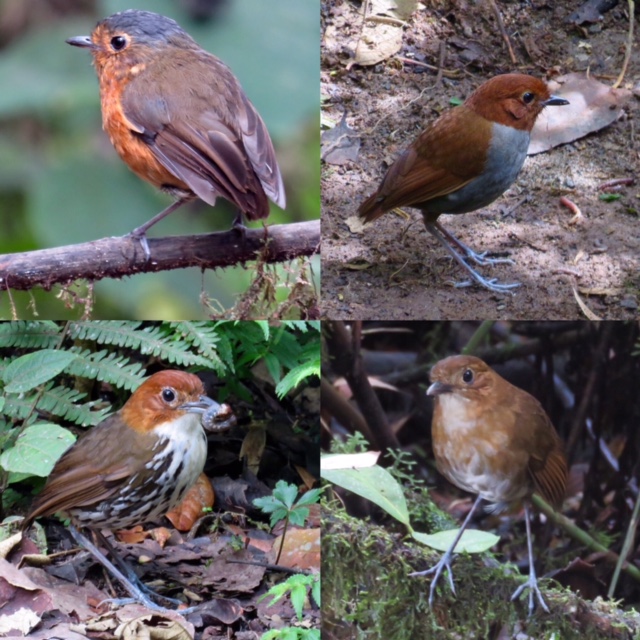
ARJAN’s DRIVE
Each and everyone of us likes birding. But having queried many birders, including top guides of well-known birdingtourcompanies, there are very few, if any, who thought they’d be able to bird for every single day in an entire year – and enjoy it.
Now, Arjan does. But that, obviously, is not the only reason he is well on his way of establishing a world record. He is extremely keen, sharp and well-prepared. Constantly reading up on available literature, he’ll only count a new Biggest Year bird after being totally convinced of his (our) ID. (For example, few days ago we both saw a bird we flushed off the forest floor: clearly a quail-dove, and purplish-black. Between the two of us we must have over a year of neotropical birding experience, so the likely ID would be: Indigo-crowned Quail-dove. Not that we counted it as such.)
Arjan has another quality: he has a hard time giving up on a bird, even though available literature suggests it’s rare. And, even during our (fortunately rare) rainy mornings, he presses on knowing there might be a bird, or even an entire flock of them, lurking around the next corner.
Sure he misses his girlfriend Camilla, his parents & friends. But, with current communication opportunities, he speaks to them almost daily – apart from spending about two hours a day writing blogs and articles, learning 30-40 new birdsounds, reading birding literature, arranging details on the next two birding months, oh, and birding and sleeping. If you don’t mind – I thought I’d relieve him from his blogging duty for a week …
Remco Hofland
October 16th AMAZING HUMMERS
At 4 AM we left Rio Claro and headed towards Parque Nacional los Nevados. This park protects one of the most venerable biomes in Colombia, the paramo. In this peculiar high altitude habitat, composed of bromeliads, bushes en grasses, one of the most spectacular hummingbirds in Colombia can be found, the Buffy Helmetcrest. Since we had rather poor views of the Green-bearded Helmetcrest we were especially keen on seeing this stunner frame-filling in the scope.
We were lucky, the weather was exceptional, sunny and zero wind en just 10 minutes after our arrival we had amazing views of a male Buffy Helmetcrest down to a few meters. For a couple of minutes we enjoyed this beauty, but then it was time to race down to reach the viewpoint for the endangered Rufous-fronted Parakeet before mist could settle over the mountains making it impossible to see this very rare bird. After a tense race against the clock Garry found no less than 10 parakeets just before the mist swallowed the very ridge they were foraging on: victory!
Further down again we visited the feeders at the hot springs of Termen del Reos. Although it looked tempting there was no time for a swim because here we could find the most beautiful hummingbird of them all, the Rainbow-bearded Thornbill. Finding this bird is luckily very easy since it regularly comes in to feed. What an amazing looking bird. Well, just look at the picture that Garry took and you can understand that we were utterly excited when we laid eyed on this dazzling hummer!
From here it was a long drive to the town of Apia, from where we switched to a 4×4 and drove up to a small reserve. Here we looked for the highly localized Yellow-headed Manakin, but unfortunately we only heard this mega.
After this dip we drove to the Birding Walhalla of Montezuma Road, where we arrived around 9 PM.
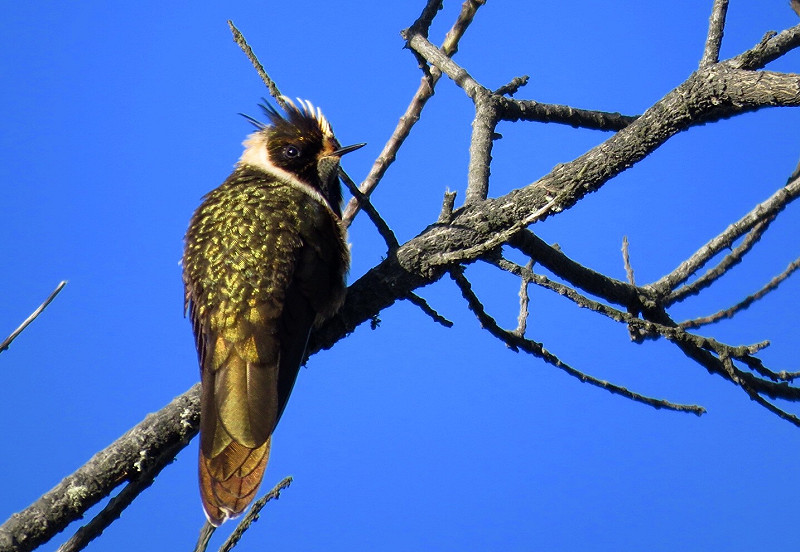
October 17th BANGSIAS!
Today we were joined by the keen Guatemalian birdwatcher John Cahill, a 20-year-old fanatic birder who will guide me in Guatemala a month from now. Great to have an extra pair of eyes and great to already plan my Guatemala trip with John.
Montezuma basically is a track that runs through continuous cloud forest ranging from 1200 – 2600 meters. In this forest some mega birds can be found including the critically endangered Munchique Wood-wren (at the top) and two beautiful and rare tanagers belonging to the Bangsia genus, namely Gold-ringed and Black-and-gold Tanager.
We started at a viewpoint below the top and within the first hour after dawn we found several stunning Gold-ringed Tanagers, a heard only Scaled Fruiteater, Star-chested Treerunner and several jaw-dropping Chestnut-breasted Chlorophonias.
As we walked down we got one star bird after another. This was due to the fact that the weather was just perfect, it started sunny and clear and gradually it got overcast with now and then a light drizzle: ideal conditions for cloudforest birding. Highlights in the morning hours where Beautiful Jay, Indigo Flowerpiercer, Black Solitaire, Cloud Forest Pygmy-owl and a cooperative singing Bicolored Antvireo. The latter being a super localized species that is only reliably found here.
The afternoon was a lot quieter, but still new birds were added to my ever growing year list. About 250 birds to go for the new record!
October 18th HARD RAIN, HARD BIRDS
This morning we left Montezuma Lodge at 5 AM and drove up to the pass, one of the only accessible – and well protected – sites for the critically endangered Munchique Wood-wren. This recently discovered species has a tiny range and clings on at four tiny pockets of stunted elfin forest in the Western Andes of Colombia.
Things didn’t start well, rain was pouring down and because so conditions for birding were horrendous. We walked up and down the track for two hours, but only heard the wren. The endangered Chestnut-bellied Flowerpiercer proved equally elusive.
Then we found a short window to operate! The rain stopped for just 15 minutes and bird activity commenced. We quickly found the wren which gave stupendous views and not long thereafter we found two Chestnut-bellied Flowerpiercers singing next to the road, mission accomplished.
We drove down hoping to dodge the rain, but lower down the weather was equally bad, resulting in three heard-only Choco Vireos that were impossible to see due to the fact that the very trees they were feeding in were covered in mist.
In the afternoon we made a radical decision. We had seen most of our targets so we packed our bags and were ready to leave, but while having lunch we decided that if we had a really good afternoon a couple of hours more at Montezuma wouldn’t hurt. So we unloaded our bags and started birding once again.
We had made an excellent choice since the rain stopped and because of that birds were quite active for this normally unproductive time of day. I was playing my Southamerican nemesis bird Lanceolated Monklet at every bend in the road as I did many times before this year, but suddenly one started calling back! We tried hard to localize this notoriously immobile bird, but after two tense minutes I located the bird. Yes! Finally I’d found my Monklet!
After dinner we said goodbye to Montezuma and headed to La Virginia, halfway between Montezuma and Jardin.
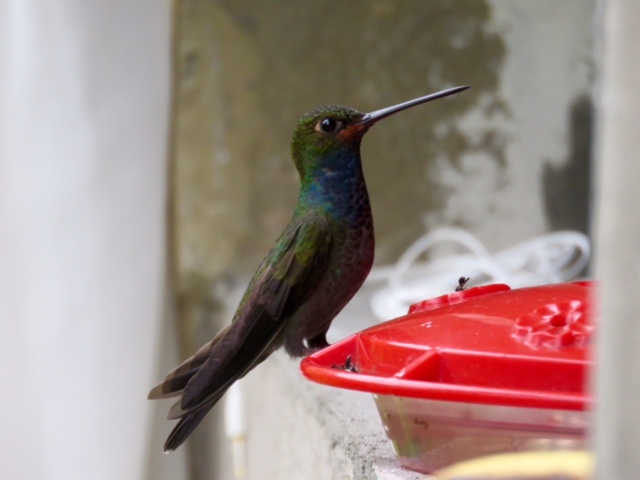
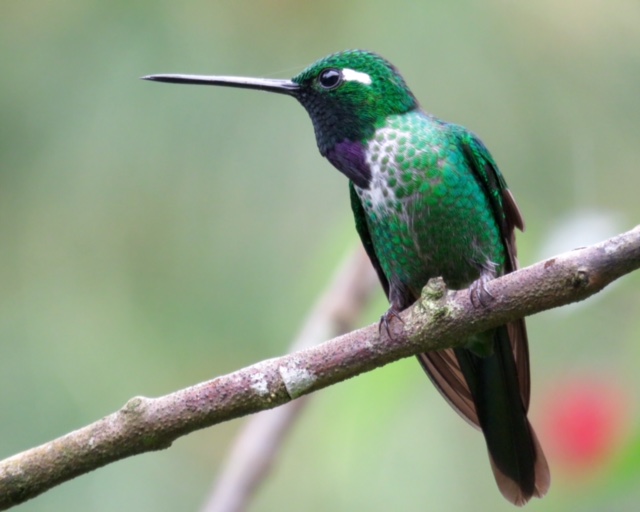
October 19th REMCO AND HIS WHITE-CAPPED TANAGER
We started our day birding the open countryside near La Virginia hoping to find the Dwarf Cuckoo. This localized species is most easily found in Colombia and given the fact that cuckoos are just cool birds, we were keen on our target.
The cuckoo proved hard, for hours we birded the open countryside, but no cuckoos. Meanwhile it got hotter and hotter and there was little shade to cool down.
It was Remco who relieved us from this burden when he found a cuckoo from the moving car, perching right next to the road! We watched a pair of these awesome birds for a while as they were hunting caterpillars just meters away. Fantastic.
Next we headed to Jardin. We arrived around 2 PM at a patch of cloud forest where Jose had seen Remco’s most wanted Southamerican bird – White-capped Tanager – several times before. We played the call of the bird and within seconds we got a response. Remco started jumping around excitedly – he is surprisingly nimble for a guy his size. And he got his Tanager, better than he could have dreamed. For half an hour we watched eight birds calling just meters away. Simply amazing! Best of course was that now we didn’t have to hear Remco wining about White-capped Tanager every half an hour 😉 Congratulations my fried, you’ve earned this bird!
We finished the day with one of the most enigmatic Colombian birds, the endangered Yellow-eared Parrot. This beautiful bird balanced on the brink of extinction for a long time, but due to the efforts of ProAves the species has made a remarkable recovery. We saw a couple of dozens of these beautiful parrots flying and perching on the very palm trees they are so depended on for breeding and roosting. Awesome.
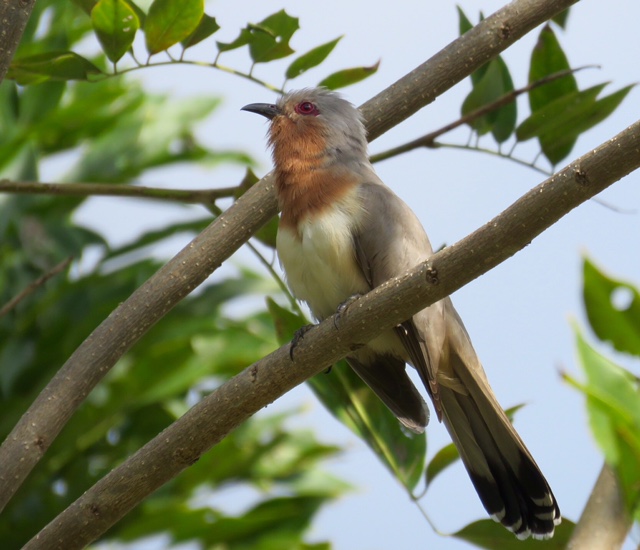
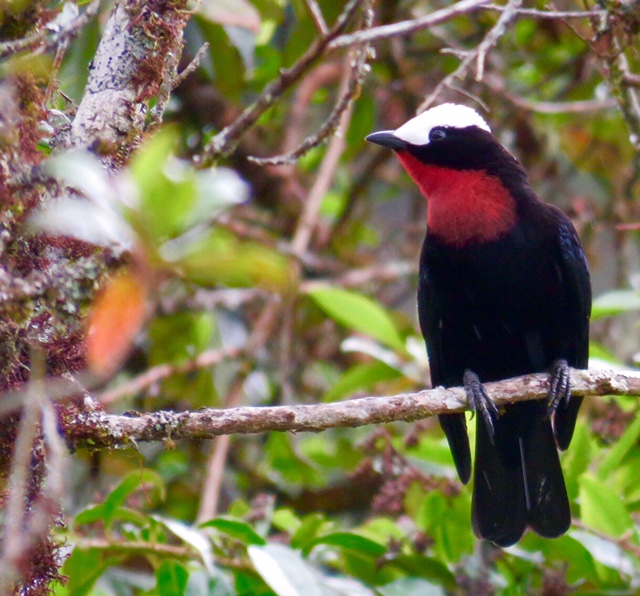
October 20th GERJON AND HIS COCK-OF-THE-ROCKS
Gerjon’s most wanted bird of the trip was the Andean Cock-of-the-Rock and since there was a lek of these beautiful birds right at the edge of Jardin we decided on starting our day with making Gerjon’s dreams come true. At dawn Jose took us to the lek and immediately we found ourselves surrounded by five male Andean Cock-of-the-Rocks. Great to see my travel companion go completely nuts like Camilla did one month ago in Peru.
After that spectacle it was business as usual with chasing rarities. The most important bird of the day was the endemic and endangered Red-bellied Crackle which we – thanks to Jose’s local knowledge – found with relative ease. Other targets in the cloud forest above Jardin were all difficult, but we did manage to find a few, including the yet undescribed (sub)species of Rufous Antpitta.
Next we commenced the long drive to Rio Claro, but we had a planned stop to look for the recently described, very local and in all likelihood critically endangered endemic Antioquia Wren. We arrived at the site at 3:30 PM thinking that we had ample time to find this bird which is supposed to be locally common at this site. You see, almost all the habitat in the Cauca valley has been destroyed and the wren – that was once more widespread – now survives in just a few patches of gallery forest along steep gullies. Here the wrens should still be easy to find.
We were proven wrong. At 5:15 PM we still hadn’t seen or heard a single wren and we – with a strong emphasis on ME – started to worry. By 5:30 PM we were quickly losing light and by that time I found myself in a state of complete panic. In an ultimate attempt to connect with this enigmatic species we raced back up with our van to one of the higher forest patches. We jumped out and Jose played the tape. Tension on everyone’s face… Bam! An Antioquia Wren sang back! A tense 10 minutes followed wherein we eventually all managed to see the wren. Garry made a legendary sound recording of these 10 minutes which he will post on dutchbirding.nl.
October 21st RIO CLARO
This morning we were joined by Diego Calderon, the chief of Colombia Birding. Originally he would have guided us himself this trip, but due to very unfortunate and very understandable circumstances he had to cancel. So it was great that he could join the party this morning. Near the small town of Cocorna we went in search of two endemics, namely the White-mantled Barbet and Beautiful Woodpecker.
We found the barbet with ease in the Secropia dominated patches of secondary forest below the town, but the woodpecker proved unexpectedly elusive. By 10 AM we had to stop our search hoping that we would connect with this species at Rio Claro Reserve.
We had breakfast at a nice roadside restaurant with the whole gang before we said goodbye to Diego and headed for Rio Claro Reserve.
Our afternoon at Rio Claro Reserve was productive. We quickly found one of our main targets, the endemic and localized Magdalena Antbird, which is restricted to the limestone karst forest in this region. After lunch we went on a steep and slippery trail to look for the Antioquia Bristle Tyrant, a rare and endangered endemic that is only reliably found in this reserve. Luckily José’s stakeout for this species was spot on and we had great views of a pair of this rare tyrant. A huge bonus at this site was a small flock of the unpredictable Sooty Ant-tanager.
October 22nd THE BEAUTIFULY DIFFICULT WOODPECKER
Last night we heard Chocó Screech-Owl, so at 5 AM Garry and I were outside our cabin trying (again) to see the bird. We didn’t get a response, but while we were trying for the Screech a juvenile Spectacled Owl started calling. Garry and I quickly got the bird in the torch and since I knew this was a new and much wanted bird for Gerjon and Remco, I raced back to the cabin to fetch them. One minute later Remco and Gerjon stood next to us in their boxer shorts and together we watched this beautiful owl. It must have been a funny sight for the owl to watch these two half naked Dutchmen down below him.
After breakfast we walked a creek towards an Oilbird Cave. The trail itself resulted in little more than a Grey-cheeked Nunlet, but for Garry, Remco and Gerjon the Oilbird cave was a big highlight. In fact they had to wade waste deep through water to see the birds – I had seen this species several times before so I did not join them – and as always when you put in a great effort the reward is extra sweet.
So far only one specialty in the Rio Claro area did not show itself, the Beautiful Woodpecker. We were all getting worried that we would miss this charismatic species since by now it was sunny, hot and bird activity had completely stopped. There was one last spot to try and in the dying seconds of our stay in Rio Claro a bird suddenly started calling! Ten Minutes later we left Rio Claro with the woodpecker in the bag.
We commenced with the six hour drive to the ProAves Cerulean Warbler Reserve, but there was one last very cool species waiting for us en route, the Northern Screamer. We found several of these cool birds along the roadside.
October 23th THE PROAVES CERULEAN WARBLER RESERVE
First a little bit of context about ProAves:
ProAves is the Colombian equivalent of the Jocotoco Foundation. They buy pieces of land which house certain endangered bird species. By turning the forest and the land which it stands on into nature reserves they secure the future of these birds. Birdwatchers that want to see these species can stay in the ProAves lodges in these reserves and all the income from this ecotourism is used to buy more pieces of land. A beautiful system of positive feedback that helps to safeguard the future of many endangered Colombian bird species.
This Colombia trip we would stay in three different ProAves lodges. Last night we had arrived at the Cerulean Warbler Reserve Lodge. The Cerulean Warbler Reserve was created to protect the wintering ground of the vulnerable Cerulean Warbler, because ProAves not just protects Colombia’s endemic birds, it also looks after the many migratory species that winter in Colombia. Besides the Cerulean Warbler there are several very rare endemic bird species that have their stronghold in this reserve and of course we were keen on tracking those species down.
Just before daybreak we found ourselves on horseback heading for the reserve and at dawn we were at the hummingbird feeders. Here we saw the beautiful endemic Black Inca. Higher up we saw the recently described Magdalena Tapaculo and we played hide-and-seek with a covey of Gorgeted Wood-quails, which only Gerjon managed to see.
We found our best bird of today in a patch of bamboo right behind our cabins, the critically endangered Niceforo’s Wren. We managed fantastic views of this very rare bird. The highlight of today however were the many North American warblers in the shaded coffee plantations below the lodge. We saw American Redstart, Tennessee, Blackpoll, Blackburnian, a Golden-winged and of course Cerulean Warbler on their wintering grounds.
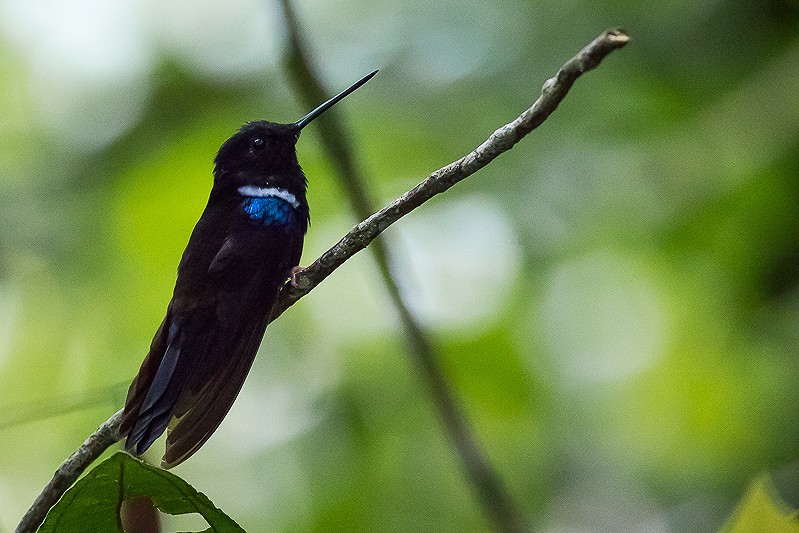 Black Inca Coeligena prunellei (Garry Bakker)
Black Inca Coeligena prunellei (Garry Bakker)
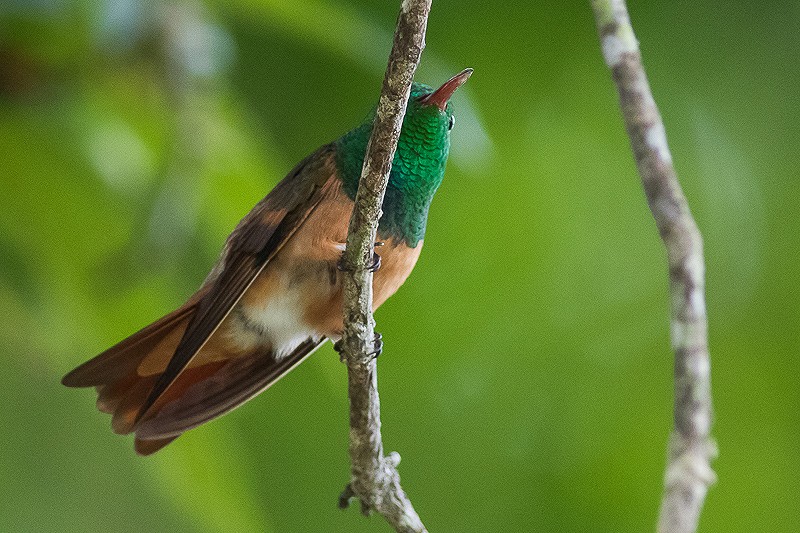 Chestnut-bellied Hummingbird Amazilia castaneiventris (Garry Bakker)
Chestnut-bellied Hummingbird Amazilia castaneiventris (Garry Bakker)
October 24th RECURVE-BILLED BUSHBIRD
Today we had the chance to come face-to-face with one of our most wanted birds of our Colombia trip, namely the Recurve-billed Bushbird. This peculiar antbird with bizarre banana-shaped bill is endemic to the hills of mid-central Colombia. It is endangered through habitat loss and nowadays is hard to find.
We had travelled all the way to the ProAves Bushbird Reserve to hopefully connect with this amazing species, but we knew that our chances of actually seeing it were slim. It was the wrong time of the year and most of the bamboo had died half a year ago.
After breakfast – with Speckled and Black-hooded Tanager on the bird table – at the ranger’s house we started our Bushbird quest. Accompanied by the ranger – this is absolutely needed here since the area is notoriously unsafe at the moment – we walked down a slippery trail down a gorge in the reserve hoping to at least hear a bushbird.
After walking down for half an hour we suddenly heard a bird calling and Jose played the call to hopefully persuade the bird to come into view, but nothing happened. After ten minutes with zero response I was about to give up when Remco shouted ‘I got the bird’! And there completely in the open an immature male Recurve-billed Bushbird was feeding on bamboo right next to the trail. Absolutely amazing! Other good birds that morning were the endemic Klage’s Antbird and Grey-throated Warbler.
The presence of armed militia in the area – actually there to protect us from potential robbers, gave us a clear signal that it was time to leave. Since we’d seen all but one of our targets, we were reluctant to leave this sometimes dangerous area.
We arrived late in the evening in Manaure, a small town at the base of the Perijá Mountain Range.
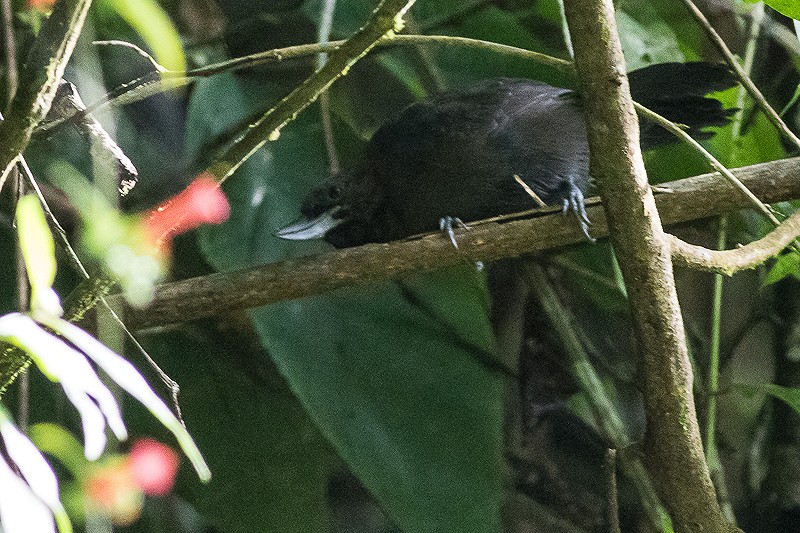 Recurve-billed Bushbird Clytoctantes alixii (Garry Bakker)
Recurve-billed Bushbird Clytoctantes alixii (Garry Bakker)
October 25th OFF THE BEATEN TRACK
At 5 AM we found ourselves in a Toyota Landcruiser going up into the Perijá Mountains. This seldom visited mountain range at the border with Venezuela has been declared ‘safe’ only very recently and to protect the last remaining elfin forest and paramo in these mountains, ProAves has bought land here and built an eco lodge. We were proud to call ourselves the first Dutchmen to visit this area, which holds four endemics and twice as many future splits.
At the lower part we birded the heavily degraded forest patches that were actually quit birdy, but this activity mostly consisted of migratory warblers and species favouring degraded habitats. We were extremely lucky – or you can better say that José was extremely sharp – to find the poorly known Perijá Brush-Finch in one of these forest patches.
After dropping our stuff at the ProAves Lodge we drove on a very bad road to the paramo where we parked our 4×4 about 2 kilometres from the boarder with Venezuela. Somewhere in this misty and rainy paramo landscape we had to find two of the least known birds of South America, namely the Perijá Thistletail, a furnarid, and Perijá Metaltail, a hummingbird. We had to work hard to find these birds and only after three hours of battling through a very wet Paramo we managed to find both birds. Luckily we got fantastic views of both species.
Other interesting stuff up here is the local race and 100 percent full species ‘Perijá’ Lacrimose Mountain-tanager and ‘Perijá’ Rufous Spinetail. Surely if more research is done in this remote place the list of Perijá endemics is bound to grow in the future.
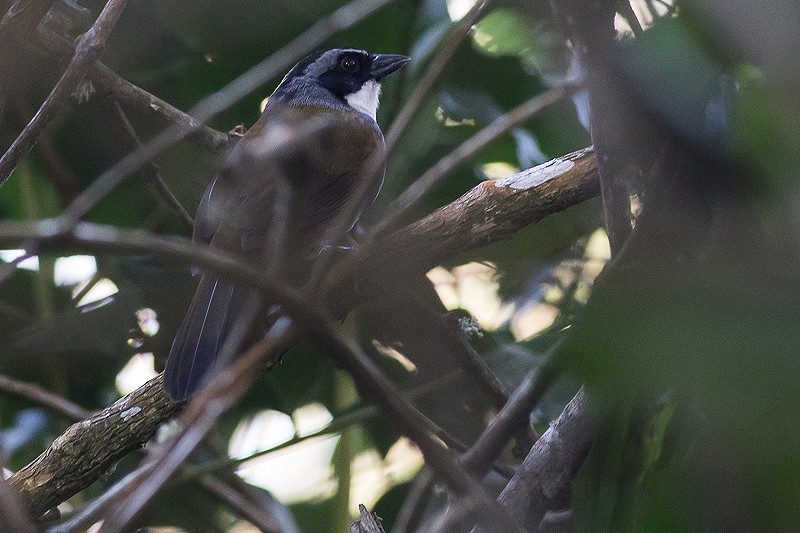 PerijáBrush-Finch Arremon perijanus (Garry Bakker)
PerijáBrush-Finch Arremon perijanus (Garry Bakker)
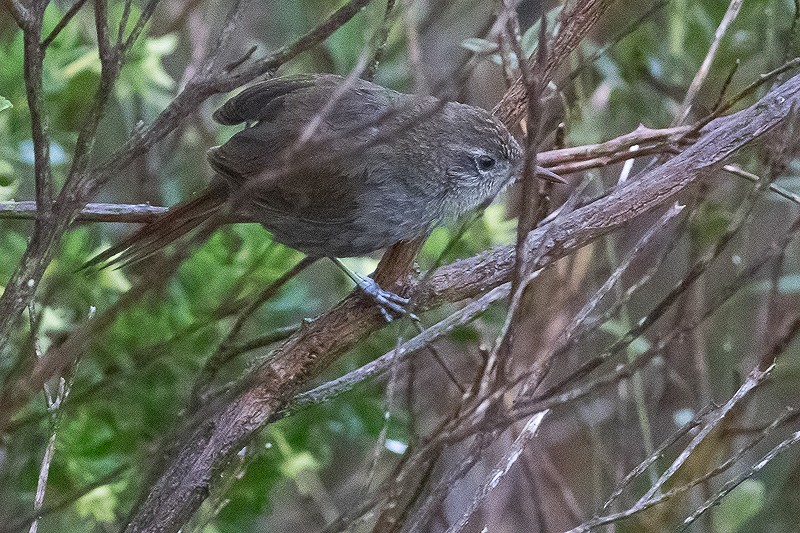 Perijá Thistletail Asthenes perijana (Garry Bakker)
Perijá Thistletail Asthenes perijana (Garry Bakker)
October 26 DOWN TO THE COAST
This morning we gave our only miss – the ‘Perijá’ Golden-bellied Starfrontlet – one more shot, but after two hours of searching we had to abort our mission to commence with the six hour drive to the small coastal town of Camarones.
In the dying seconds of the day we reached our only possible site for Rufous-vented Chachalaca and by some stroke of incredible luck we found our target within one minute after leaving the car. Now there was one last target to find that was only possible today, the rare Todd’s Nightjar, but dark clouds were assembling above our heads and gradually it started to rain. Luck was again on our hands however since just as we were about to give up a Todd’s Nightjar came straight to the tape and gave a fantastic flyby!
Then it started to rain, the biggest rainstorm I’ve ever witnessed. It was pouring down so heavily that I had to weir only my swim shorts to get from our accommodation to the restaurant on the other side of the clearing. It even rained in our rooms, in fact there was a layer of water in all our rooms. Ridiculous!
October 27th CLEANING UP AROUND LOS CAMARONES
We had a crazy difficult mission this morning, namely to clean up all the specialties – at least 15 species – around Los Camarnes before breakfast. Luckily the weather had improved and the heavy rain from last night had disappeared over the horizon.
The dry forest around Los Camarones was a welcome change to birding in humid montane forest and to make things even more enjoyable the rain storm from last night had seemed to cause a warbler ‘fall’. We saw 8 different warbler species and among these were Magnolia and Chestnut-sided, both rarities in Colombia. We also managed to find all but one of our targets – Chestnut Piculet – and highlights included the gaudy Vermillion Cardinal, the localized Tocuyo Sparrow and the beautiful Orinoco Saltator.
After breakfast we headed towards the Sierra Nevada de Santa Marta. En route – again thanks to José’s spot-on stakeouts – we quickly picked up White-bellied Antbird, Black-backed Antshrike and Lance-tailed Manakin.
We arrived in the foothills of the Santa Marta Mountains just before nightfall which gave us half an hour of birding time. In that short time span we saw the stunning Golden-winged Sparrow, Santa Marta Foliage-gleaner and a hummingbird which, judging by Garry’s pictures, could very well be the very rare and seldom photographed Santa Marta Sabrewing.
After two hours on the worst road I’ve ever been on – Santa Marta has been hit hard by a huge hurricane recently – we arrived at the wonderful El Dorado Lodge. Here we got a very warm welcome and enjoyed the fantastic food, fast Wi-Fi and hot showers. To me it is absolutely amazing that the El Dorado staff managed to fix this place so well after being struck by such a huge catastrophe. After dinner we made a short walk down from the lodge, joined by local birder and guide Gabio Utria. Finding the recently discovered Santa Marta Screech Owl proved not that difficult, with Remco noticing it calling within a couple of minutes. Although the bird was very close, dense foliage prevented views unfortunately.
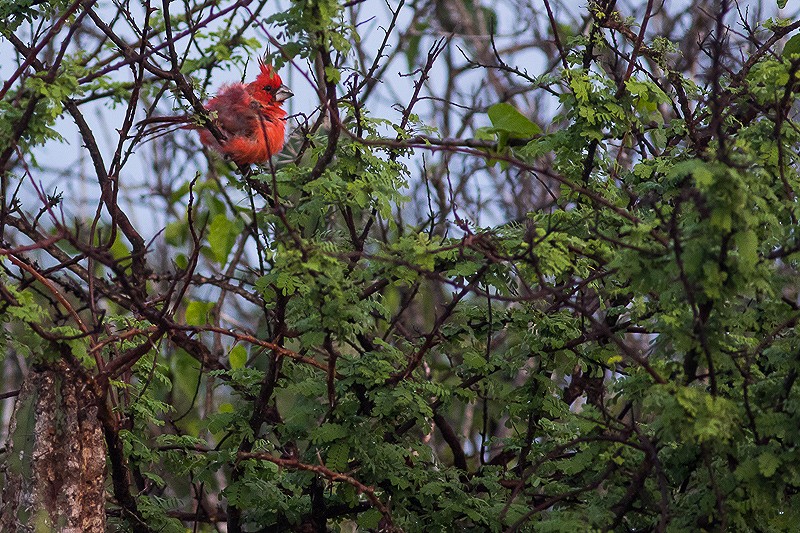 Vermilion Cardinal Cardinalis phoeniceus (Garry Bakker)
Vermilion Cardinal Cardinalis phoeniceus (Garry Bakker)
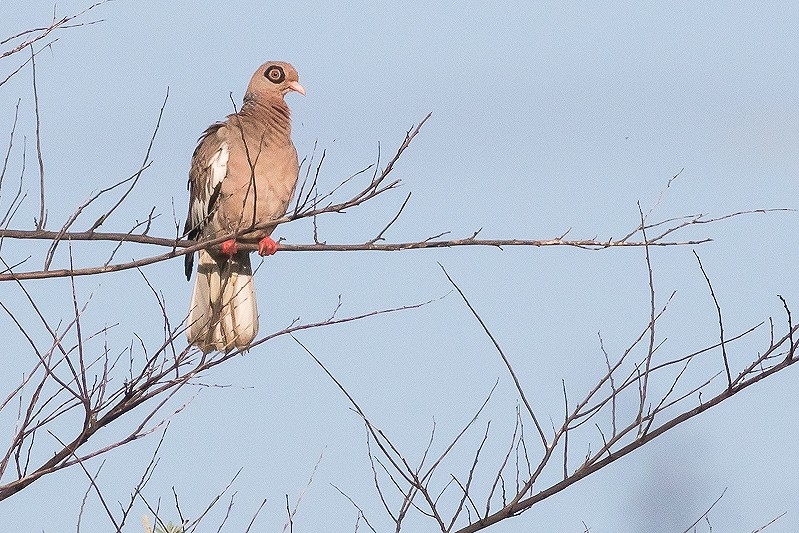 Bare-eyed Pigeon Patagioenas corensis (Garry Bakker)
Bare-eyed Pigeon Patagioenas corensis (Garry Bakker)
October 28 SANTA MARTA ENDEMICS: A RACE AGAINST THE CLOCK
Due to our crazy schedule targeting all but ten of Colombias endemics, we had just one full day at El Dorado and in that single day we had to find as many Santa Marta endemics as possible. Luckily we had José who pushed us to arrive at the highest part at the crack of dawn. This meant that we had to leave at 4:00 AM. When we arrived at the elfin forest it was misty, but thanks to our early arrival birds were active and singing. We quickly found Santa Marta Warbler, -Wren, -Mountain-tanager, -Brush-Finch, Yellow-crowned Whitestart and I was very lucky to see a Black-backed Thornbill attending a flowering Bromeliad. Unfortunately it went all too fast for the rest to connect with this very rare bird.
Since we had little time on our hand we had all agreed that we would have to suffice with heard-only Tapaculos and Antpittas, however we broke this agreement with every Rufous Antpitta, Santa Marta Antpitta and Brown-rumped Tapaculo we heard and 3 hours later we had seen only the tapaculo and wasted a lot of time on trying to see the antpittas. Of course I’m doing a record attempt, but I’m still a birdWATCHER! In our attempt to see these birds we had lost a lot of time, which meant that we had to have lunch very quickly at the lodge, pack our bags and head down as fast as possible. Unfortunately it had started raining, which made our mission next to impossible. About eight target birds in less than two hours…
We had to accept the fact that we dipped White-tipped Quetzal, Yellow-billed Toucanet and Santa Marta Blossomcrown. We had passed their preferable altitude and we were simply running out of time. However we had an incredible run of birds in the last hour of daylight. Santa Marta Tapaculo, Santa Marta Antbird, Coopman’s Tyrannulet, the soon to be split Bangs’s Wood-Wren and, finally, Colombian Brushfinch in the fading light. Wow, what a last full day in Colombia! With 90 percent of the Santa Marta endemics in the bag within a single day, we have no reason to complain!
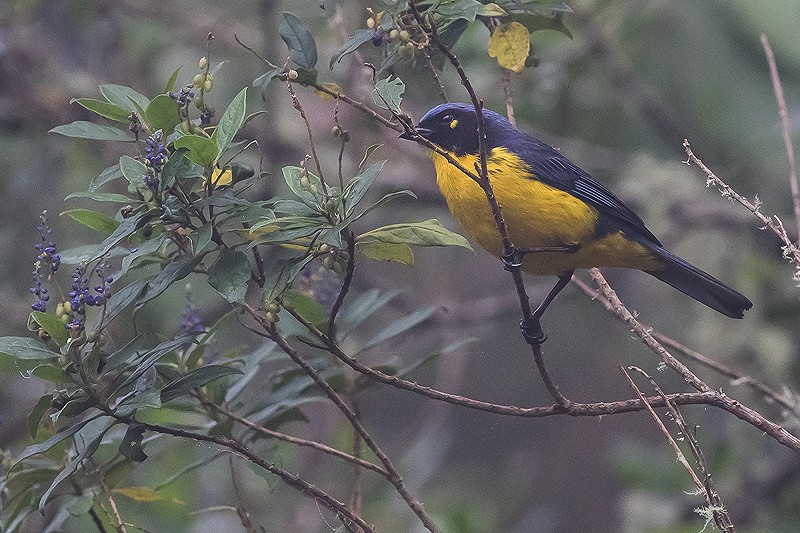 Santa Marta Mountain-Tanager Anisognathus melanogenys (Garry Bakker)
Santa Marta Mountain-Tanager Anisognathus melanogenys (Garry Bakker)
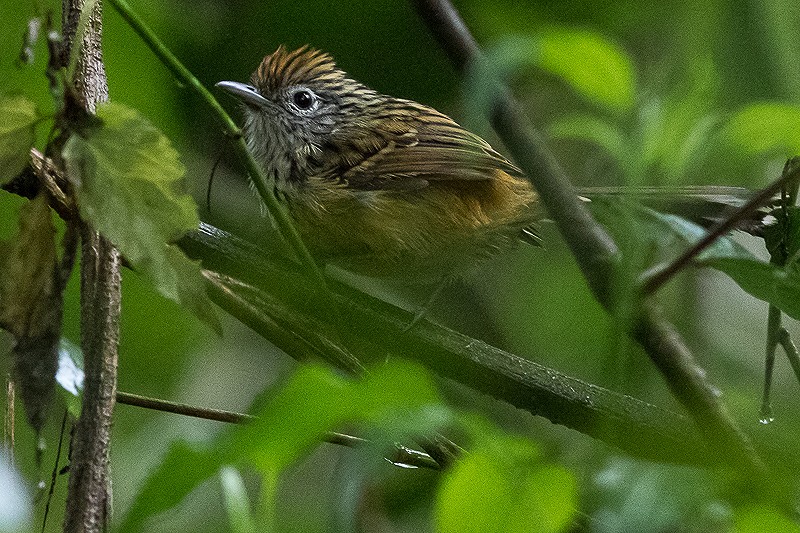 Santa Marta Antbird Drymophila hellmayri (Garry Bakker)
Santa Marta Antbird Drymophila hellmayri (Garry Bakker)
October 29th GOODBYE MIGHTY SOUTH-AMERICA!
Already my last morning on the mighty continent of South-America. The past three months and three weeks have been crazy. I saw more than 2300 new birds for my Biggest Year and I’m just 94 birds away from a new world record. With two months to go wherein I will travel through Cuba, Panama, Costa Rica, Guatemala, Mexico, Jamaica, the United States, Vietnam, Taiwan and finally Japan, I still believe that 7000 species is possible. It will be tough and all the pieces of the puzzle have to fall together, but it is possible. One thing is certain, I will give it everything that I got. This means even longer hours, shorter lunches, less sleep, better preparations and total dedication.
Our last morning in Colombia was enjoyable with – among others – the endemic Chestnut-winged Chachalaca and an unexpected fly by of six Military Macaws. My final South American new bird was Swainson’s Hawk, a group of seven birds migrating overhead literally two minutes before boarding my flight to Havana!
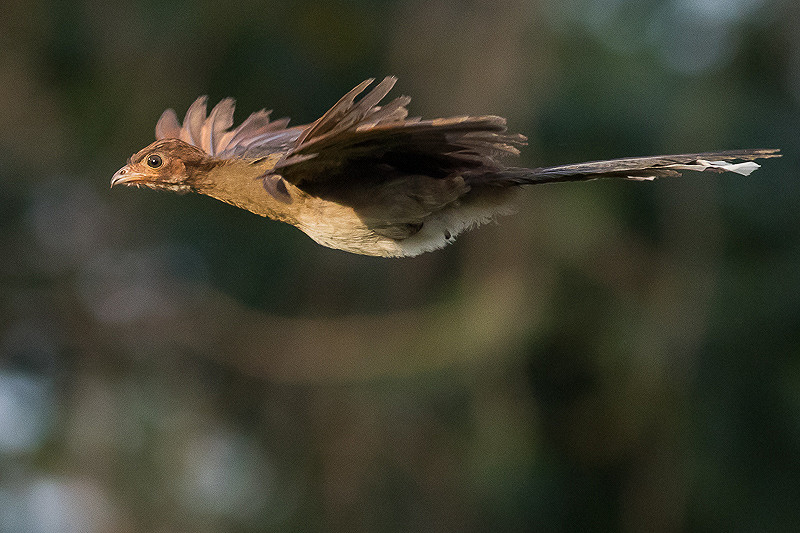 Chestnut-winged Chachalaca Ortalis garrula (Garry Bakker)
Chestnut-winged Chachalaca Ortalis garrula (Garry Bakker)
I want to thank my travel buddies Garry Bakker, Remco Hofland and Gerjon Gelling for coping with me these stressful, but amazing weeks. I enjoyed your companionship a lot and you are all amazing birders.
José Castano, you are a terrific bird guide and a wonderful person to have spent these 20 days in Colombia with. Diego Calderon and COLOMBIA BIRDING, thanks for putting this rollercoaster ride together, it was incredible. As Arny would say: ‘I’ll be back’.
Arjan Dwarshuis

.JPG)
